
In 2024, How To Convert Video Voice to Text Online for Free?

How To Convert Video Voice to Text Online for Free?
Do you ever struggle to understand or keep up with long videos? Maybe you need the information in text format for easier note-taking or sharing. However, transcribing the video content manually can be a time-consuming task.
The good news is that you can easily convert video voice to text online for free. In this guide, you’ll explore several ways to do it using the best tools and some tips if you encounter any issues. So, whether you’re dealing with online meetings, e-learning content, or working on global campaigns, this article has a solution for you. Let’s start.

Part 1. For Online Meetings on Desktop: Convert Video Voice to Text by Descript
Joining online meetings might get tricky when crucial details slip by because of fast speakers or background noise. Don’t worry – Descript has your back. It is a versatile video recorder that doubles as a video voice-to-text converter online.
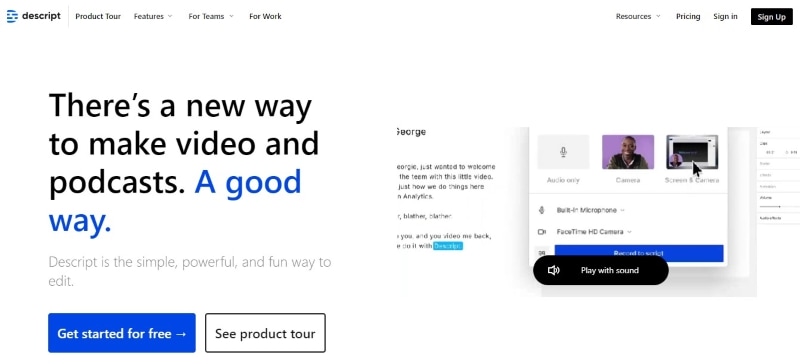
With Descript, you can easily review key points, find specific moments, and share the transcript with colleagues who couldn’t make it. Say goodbye to missed details and hello to smoother online meetings with Descript.
How To Convert Video Voice to Text Automatically Using Descript?
With Descript, online meetings become active and focused. Ready to give it a try? Follow these steps below to convert your recorded video to text files online with Descript:
- Step 1: Launch Descript from your web browser and create an account.
- Step 2: Click + New in the top right corner of the Projects on the home page. Then, go to Video project > Add file, and select your video file from the pop-up window.

- Step 3: Descript will automatically begin transcribing your video once it’s uploaded.
- Step 4: You’ll see the converted text on the left. Just click on it to make any changes you need.
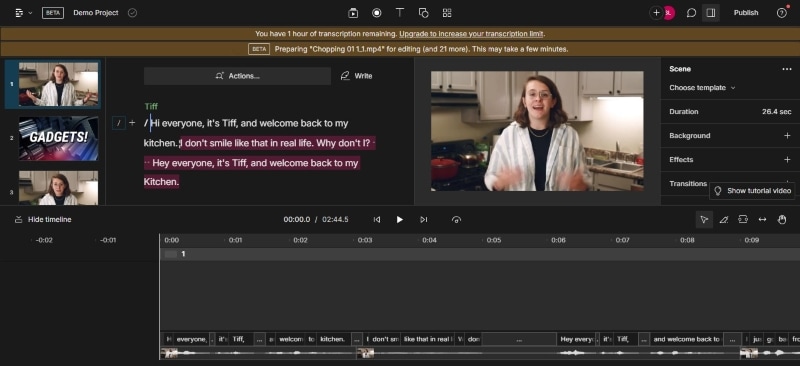
Tips:
Click the “**Actions…” button on the text editor and select “Remove filler words…**” to search and delete filler words in the text automatically.
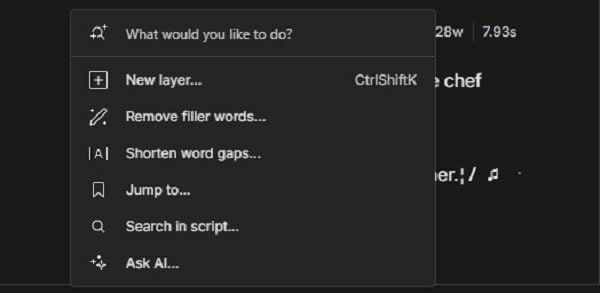
- Step 5: Once you’re happy with the transcript, you can export it in various formats. Go to File in the top navigation pane and select Export.
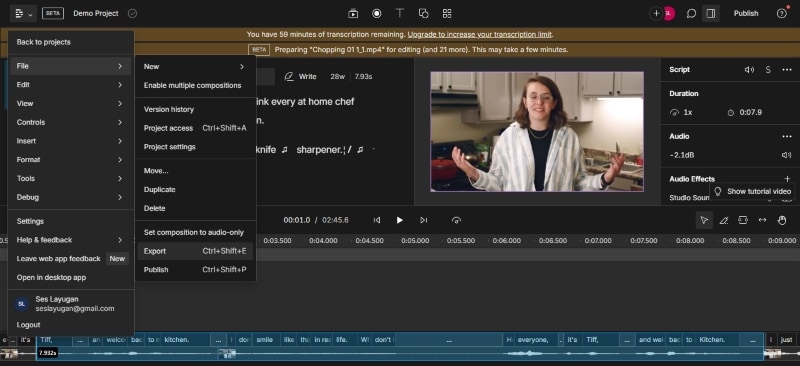
- Step 6: Go to the Transcript tab bar from the pop-up window. Choose the desired format (TXT, DOCX, etc.) and customize the export settings.
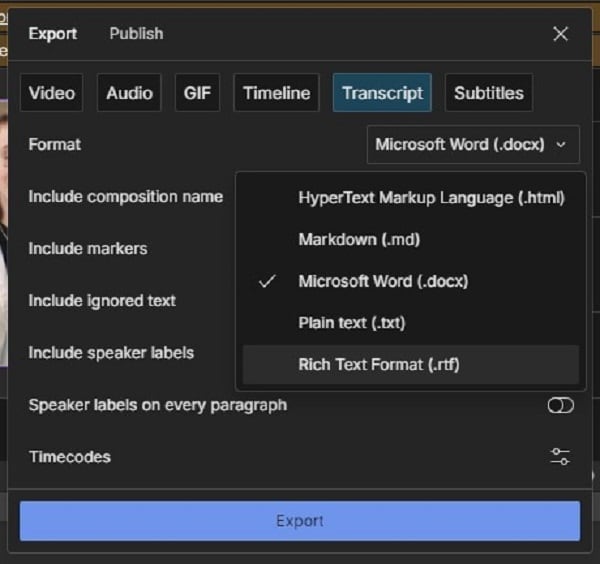
Part 2. For E-Learning Online: Convert Video Voice to Text by Happy Scribe
Getting new skills through e-learning is great, but listening to long video lectures can be tiresome. But with AI tools like Happy Scribe, it is easier to study. It has an intuitive interface and lets you convert video voice to text online for free.
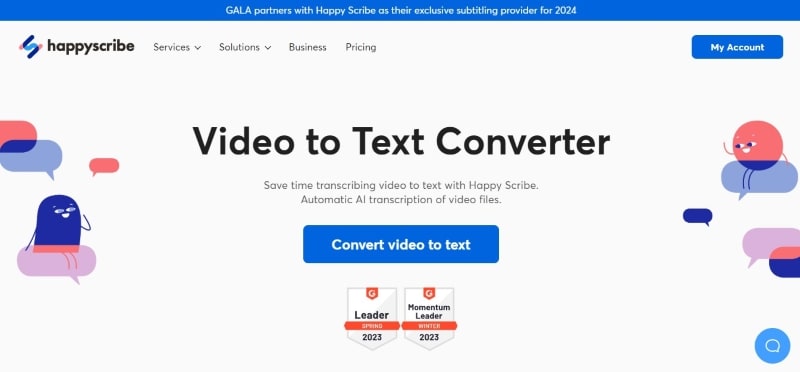
Happy Scribe’s AI transcribes your video, whether pre-recorded or from YouTube, giving you a text version of the lecture. Now, you can review the important things at your speed and find specific info faster.
How To Convert Video Voice to Text Using AI With Happy Scribe?
You can use Happy Scribe as a YouTube video voice-to-text converter online. The first 10 minutes are free; you can try it out for short videos or snippets. Here’s how to use Happy Scribe for video transcription online:
Step 1: Head to Happy Scribe’s website and log in to your existing account. If you’re a new user, sign up for a free account.
Step 2: Choose the upload source:
Click Upload a fileand select your video from your desktop folders.
Paste the public video URL from YouTube, Google Drive, and more into the designated field.
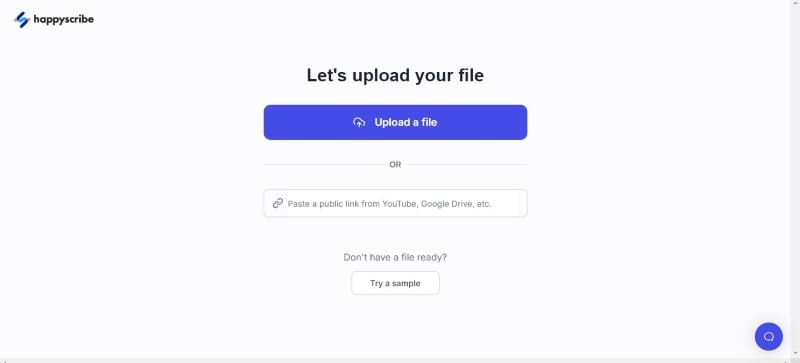
- Step 3: A pop-up window will appear once you’ve chosen the upload source. Choose the language spoken in your video from the dropdown menu. Then, select Machine generated as the transcription method.
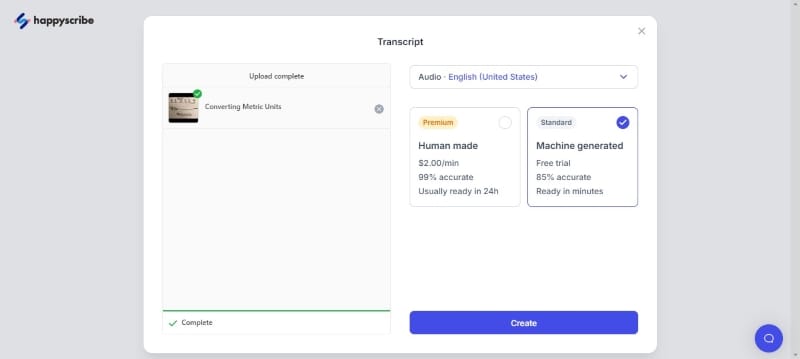
- Step 4: Click Create after setting your options. Happy Scribe YouTube video voice-to-text converter online will upload and process your video.
- Step 5: Happy Scribe will automatically generate a transcript. Use the built-in editor to click on any section of text to edit and correct mistakes. You can also control playback speed to make editing easier.
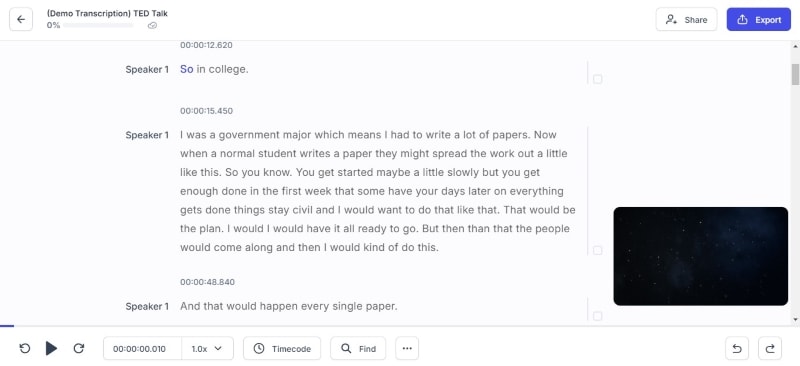
- Step 6: Once done editing the transcript, click Export from the upper right navigation pane. Since you are using the app for free, you can download it in text document and SRT file formats. Click Export 1 file to save the transcript to your computer.
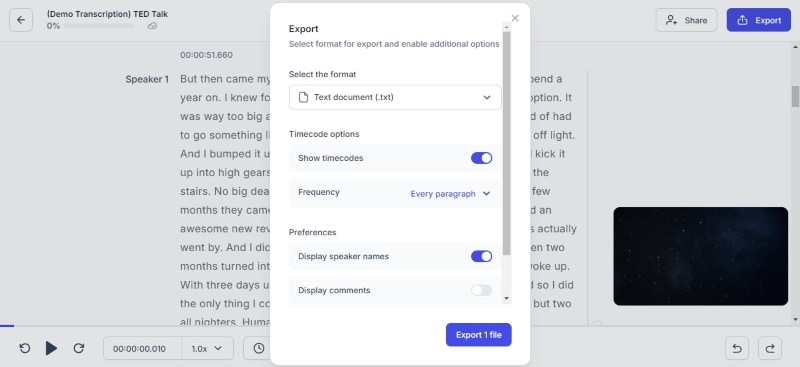
Moving beyond desktop meetings and e-learning, businesses often need an easier and faster way to translate video content for a global audience. That is where AI video translation can help you. In the next part, you’ll explore how Wondershare Virbo can help you efficiently translate video voice to text in multiple languages. Read on to make your marketing materials accessible to a wider audience.
Part 3. Virbo: Best Video Voice-to-Text Translator Online for Global Marketing
When taking your brand global, language barriers can be a challenge. But here’s the good news: with Virbo, it’s doable. One of its highlights is the ability to accurately translate video voice to text.
Virbo makes global marketing easier.

Get Started Online Free Download
This app uses AI to transcribe your video’s audio into text. Then, it lets you translate that text into different languages. Want to go the extra mile? Add these translated captions to your video, and voila! You’ve made your content accessible to viewers worldwide. This way, you can create professional, multilingual video content that expands your reach and increases brand recognition across borders, all within a single platform.
Here’s what makes Virbo the best video voice-to-text translator online for your global marketing endeavors:
- **Support for 20+ Languages:**With Virbo, you can translate video voice to text in different languages, including popular choices like Spanish, English, Chinese, and more.
- **Cross-Platform Compatibility:**Marketing knows no borders, and neither does Virbo. Whether you’re a seasoned techie or a casual user, Virbo seamlessly adapts to your workflow. It works on Windows desktops, iOS, and Android devices and even directly on your web browser.
- **Easy To Use:**Virbo understands that time is precious, especially in business. That’s why it boasts an intuitive interface that anyone can navigate easily.
- **High-Quality Output:**When it comes to your brand message, clarity is paramount. Virbo ensures your translated content maintains its original meaning and impact. Its high-quality translation output guarantees your message resonates with your global audience just as intended.
- Budget-Friendly App: Reaching a global audience shouldn’t break the bank. Virbo offers its powerful features at an affordable price, making it an excellent choice for businesses of all sizes. Now, you can translate video voice to text without worrying about hefty costs.
How To Translate Video Voice to Text Automatically Using Virbo AI?
Virbo offers free video translation with subtitles, up to 2 minutes per video. Here’s how to translate video voice to text online in a few easy steps:
- Step 1: Click Translate Video Online from the Virbo video translator webpage. You can also download the app on your desktop. Then, create or login to an account.
Get Started Online Free Download
- Step 2: Upload your video file in MP4 or MOV format. Select the language spoken in your video from the dropdown menu. Then, choose the language you want the subtitles for and translate the text into. Click Translate this video to continue.
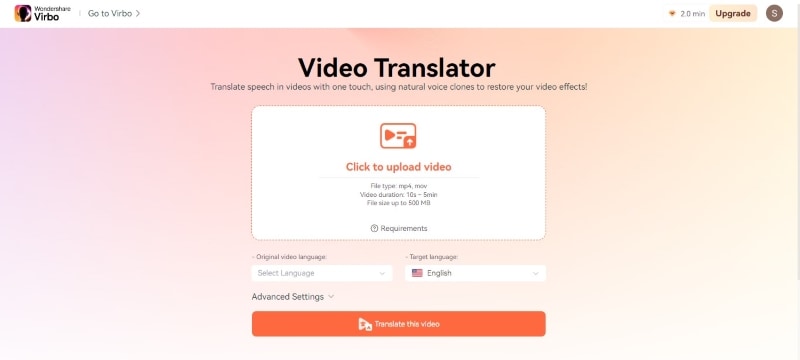
Tips:
Advanced Settings (Optional):
- **Subtitle:**Enable this to generate subtitles in the target language based on the transcribed text.
- **Proofread video script:**This allows reviewing and editing the transcribed text before translation.
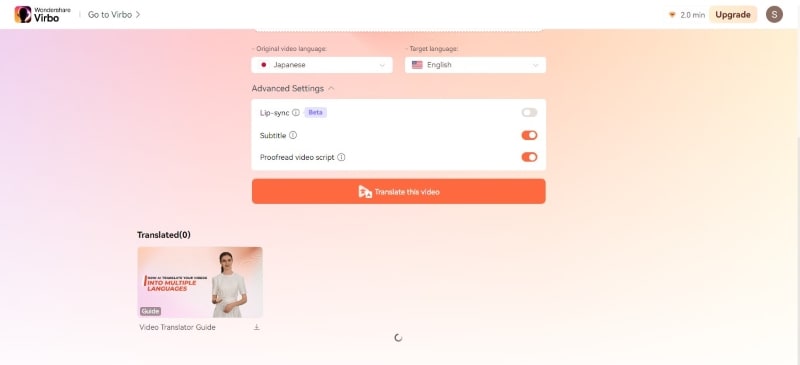
- Step 3: Virbo will process your video. This may take some time depending on the video length.
- Step 4: Review and edit any errors on the text editor before proceeding. Once satisfied, download the subtitles file (SRT format).
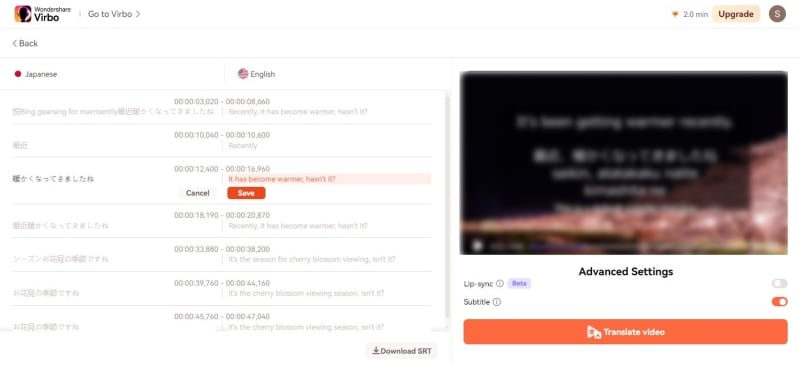
- Step 5: Click Translate video to add the translated text or subtitle to your original video. After processing is complete, Virbo will provide you with a preview of the translated video with subtitles (if enabled). If you’re satisfied with the results, click the Download icon to save the translated video with subtitles to your computer.
Part 4. Troubleshooting Issues When Converting Video Voice to Text
Creating clear and accurate transcripts is essential for professional settings. Here’s how to avoid common pitfalls that can impact transcription quality:
Issue 1: Background Noise
Solution: Noisy recordings can cause problems with transcription accuracy. Luckily, many video editing programs have noise-reduction features. Running your audio through one of these before conversion can make a big difference.
Issue 2: Accents or Dialects
Solution: Most speech recognition software is good these days, but accents and dialects can still trip them up. Check your software’s settings for options to adjust the recognition model. Some programs even let you upload a sample of the speaker’s voice to improve accuracy.
Issue 3: Punctuation Errors
Solution: Some software offers built-in punctuation correction you can use. If unavailable, find a separate grammar tool after conversion. Always proofread the transcript yourself for any missing punctuation.
Issue 4: Overlapping Voices of Speakers
Solution: If the video has multiple speakers, try software that can differentiate voices. This includes interviews and panel discussions. You can always transcribe each speaker’s section if that’s not an option. Then, add timestamps to identify speaker changes in the transcript.

Issue 5: Inconsistent Transcription Format
Solution: Most video-to-text software allows you to format after the converter generates the transcript. You can adjust fonts, add paragraph breaks, and even format speaker identification within the program. Also, you can always export the transcript to a word processor for in-depth formatting.
Conclusion
You learned several ways to convert video voice to text online for free and the best apps for it. These tools make videos easier to understand, whether recorded or uploaded from websites like YouTube.
Now, you also know the best app to translate video voice to text. Virbo allows you to translate your videos into different languages using AI, making your content global. So, explore these tools, see how video text conversion helps, and choose the app that fits you best.
Translate Video From Japanese to English Online for Free
Let’s say you’re a business owner or a content creator in Japan. If you want to broaden your horizons, you may need to translate videos from Japanese to English. This is because English is spoken globally. You can sell more, share knowledge, and connect with English speakers worldwide.
For streaming platforms, turning Japanese content into English is a ticket to reaching audiences all over the globe. And businesses using Japanese tech might need translated training videos for their remote workers.
Seeing this growing need, it’s clear you need effective video translation solutions. So, we’ve created a guide to help you choose the best method for each step, including using AI. Finding the right way to translate videos is important, so keep reading!

Part I. Completed Process To Translate Videos From Japanese to English
When you want to translate a video from Japanese to English, you can follow some general steps, no matter how you decide to do it. Let’s break down each step for you:
- Step 1: Video Transcription
Before you can translate, you need to understand what’s being said. So, the initial step is to do a video transcription. You can either hire professionals or use a Japanese-to-English video translator app to convert the spoken language to text.
Transcription captures all the Japanese dialogue, ensuring the English translation is spot-on. Having the text file lets you edit it, like shortening sentences or adjusting cultural references. This results in a smoother and more natural English video for you.
- Step 2: Translation
Once you have the transcript, you can translate the Japanese text into English. A good translation ensures the original message is accurately conveyed in the new language. It avoids any misunderstandings or misinterpretations for your English viewers. You have two options to do it. Both have strengths and weaknesses, so let’s see which suits your needs best.
- Professional Human Translation Services
When you want to translate a video from Japanese to English, a pro can make the sentences sound right for your audience. These professionals tweak the tone to be natural and engaging. If you go to translation agencies, they make sure the work is top-notch by going through strict editing and reviewing. However, human translation services cost more and take a bit more time than machine translation tools.
- Machine Translation Tools
Machine translation tools are fast and affordable. They can be a good option for short, simple videos where perfect accuracy isn’t critical. But it often struggles with complex language, cultural references, and humor.
- Step 3: Timing and Implementation
Let’s talk about making the Japanese to English video translation seamless. After translating, you want the words to match the original rhythm and pace of the speaker in the video. It keeps things feeling natural and engaging for you, the viewer. Plus, speakers use non-verbal cues like jokes, emotions, and pauses. Matching the translated text with these visual cues keeps the video’s meaning and impact intact.
How to do it? Professional workflows often use timecode, which gives each video frame a unique timestamp. It ensures super precise subtitle placement for that perfect synchronization. Some video editing tools even have “waveforms” to help visually line up subtitles with the spoken parts.

Here are several ways to add the translated Japanese text to your video:
- Subtitles
Subtitles are like on-screen translators for you. They show the English dialogue while the original Japanese audio goes on. It helps you understand if you get the visuals but not the language. The focus is on getting the main point across and sometimes making the sentences shorter for easier reading.
- Closed Captions
Like subtitles, closed captions (CC) are words shown on the screen. They go beyond spoken words, covering all the sounds you hear, like dialogue, music, and even background noises. The main goal is to help you, especially if you’re deaf or struggle with hearing. So, if you’re aiming for videos everyone can enjoy, try a video translator from Japanese to English with CC capabilities.
- Dubbing
Dubbing is a more intricate process where the original Japanese audio track is completely replaced. Voice actors step in to record the translated script in English. They try to sync up their words with the lip movements of the characters on screen. It makes it seem like the characters speak English right from the start, giving you a more immersive viewing experience.
- Voiceover
In this method, a narrator reads the translated script in English over the original Japanese audio. It’s often used in documentaries or educational videos when you need more info beyond just the dialogue.
- Step 4: Final Review and Approval
Alright, so you’re at the last step now. You’re giving the translated video a good check to ensure everything’s spot-on – accurate, consistent, and top-notch quality. It means looking out for any problems in the translation, timing, or how you choose to do it. Once you give the thumbs up to the final version, you’ve got a smooth and effective English video ready for your audience.
You might find the previous steps tedious and time-consuming. But what if you could translate your video from Japanese to English in minutes? That way, you could reach new markets and expand your influence faster. AI video translators like Wondershare Virbo can help you spread your work, passions, and stories to a global audience. Read on to learn more.
Part II. Virbo: Realistic AI Japanese to English Video Translator
You’re excited about your new product, but your explainer video feels like it’s only speaking to half the world. You know the potential exists, but the language barrier holds you back. Or perhaps you’ve captured stunning footage from your recent trip to Kyoto, but sharing it with your followers feels like a lost cause.
Here’s the deal: you don’t have to stick to a small crowd.

Get Started Online Free Download
Virbo uses the latest AI tech to automatically translate, dub voice, and add synced subtitles to your Japanese video. This app is simple to use and can translate video content into over 20 languages. Virbo translates Japanese to English videos in a few minutes – all free for videos under 2 minutes!
Here’s what makes Virbo stand out:
- Precise Lip-sync: Say goodbye to awkward, out-of-sync translations. Virbo AI video translator ensures the translated dialogue seamlessly matches the speaker’s lip movements and facial expressions, creating a natural and engaging experience (still in beta, but getting better every day!).
- AI Cloning Voices: Add engagement with Virbo’s AI-cloned voices that capture the essence of human speech. Choose from a range of natural-sounding voices that express the right emotions and add personality to your content.
- Soundtrack Reserved: Don’t lose the original soundtrack that sets the mood. Virbo allows you to keep it intact, enhancing its impact even in different languages.
- Versatile Compatibility: Virbo works across various platforms, including Windows, iOS, and Android. You can even use it online for ultimate flexibility.
- Affordable Excellence: Experience the power of AI video translation without breaking the bank. Virbo offers high-quality solutions at affordable prices, making them accessible to everyone.
Part III. How To Translate Japanese to English Video Using Virbo Automatically
Using Virbo AI video translator can help you be more productive. Here’s how to translate a video in Japanese to English online for free:
- Step 1: Go to Virbo AI video translator online from your browser for quick access. You can also download the app for your desktop. Once you’ve chosen your access point, sign in using your existing Google, Facebook, email, Apple, or Twitter account.
Get Started Online Free Download
- Step 2: Choose and upload your Japanese video file from your local storage. Ensure the video is between 10 seconds to 5 minutes long and in MP4 or MOV format, up to 500 MB for optimal processing.
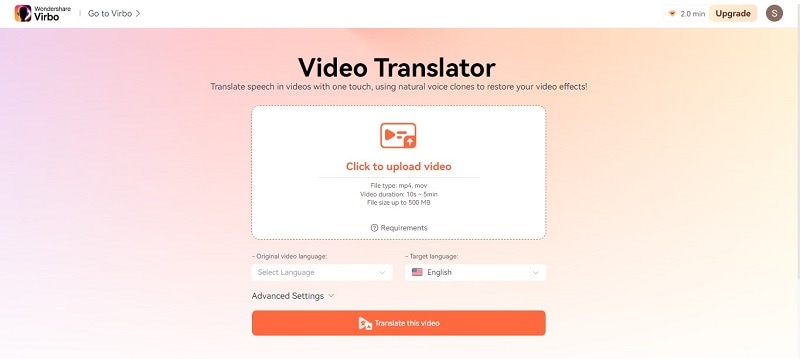
- Step 3: Specify Japanese as the Original video language and English as the desired Target language.
- Step 4: Virbo offers Advanced Settings to customize the translated view result. Toggle on the Lip-sync, Subtitle, and Proofread video script switches to enable them when needed.
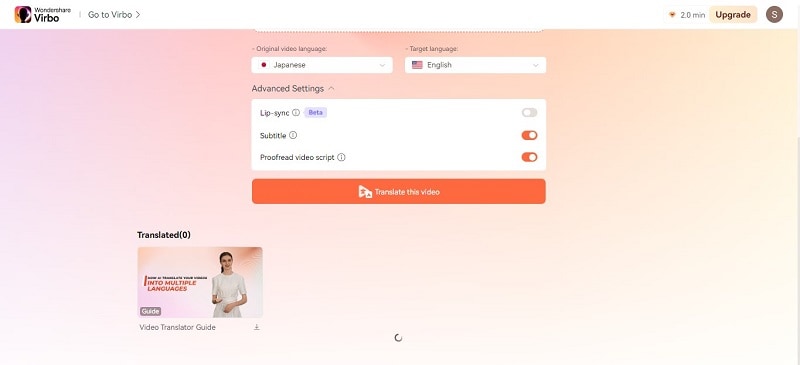
- Step 5: Click Translate this video to start the translation process once everything is set.
- Step 6: Wait a few moments while Virbo performs video transcription. Review the text and edit if needed.
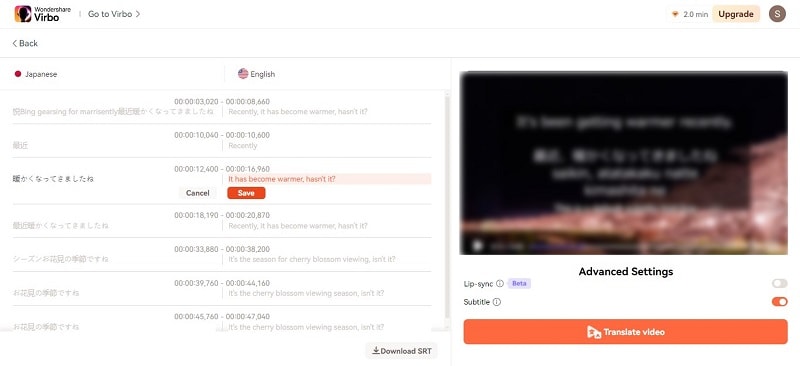
- Step 7: Click Translate video to proceed, then the video will go to the queue.
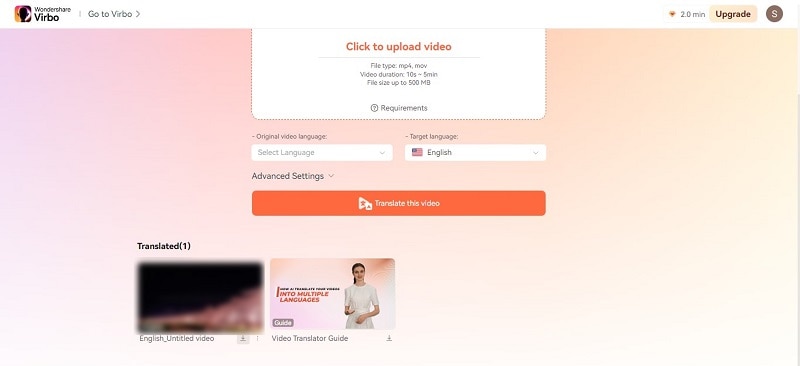
- Step 8: After completion, you can preview the translated video before downloading the final English version.
Part IV. How To Achieve the Best Video Translation Results?
You can’t always translate a video from Japanese to English without a few difficulties. Here are some ways to make the process easier for you:
Divide the Script Into Manageable Chunks
Break down the script into smaller sections like sentences, phrases, or even shorter segments depending on the video’s pace and complexity. It allows for more precise timing adjustments later.
Use a “Shadowing” Technique
As you watch the video, read the translated text out loud. Adjust the subtitle timing to match how you naturally speak. Doing this makes the flow feel more natural for you and the viewers.
Test and Refine
Now that you’ve set the timing for the subtitles, it’s time to put them to the test with your target audience. This step is important because it helps you catch any timing problems, awkward phrasing, or cultural differences that might have slipped through during editing.
Listen to what your audience says, and then use that feedback to tweak the subtitles. Your goal is to make sure they’re clear, short, and match the audience’s culture.
AI for Pre-Translation Tasks
Take advantage of AI tools for speech-to-text conversion and automatic subtitle generation. It can save time, but always proofread for accuracy and natural flow.
File Compatibility
Ensure your chosen translation service or tool supports the format of your video file. The common formats include MP4, MOV, and AVI.
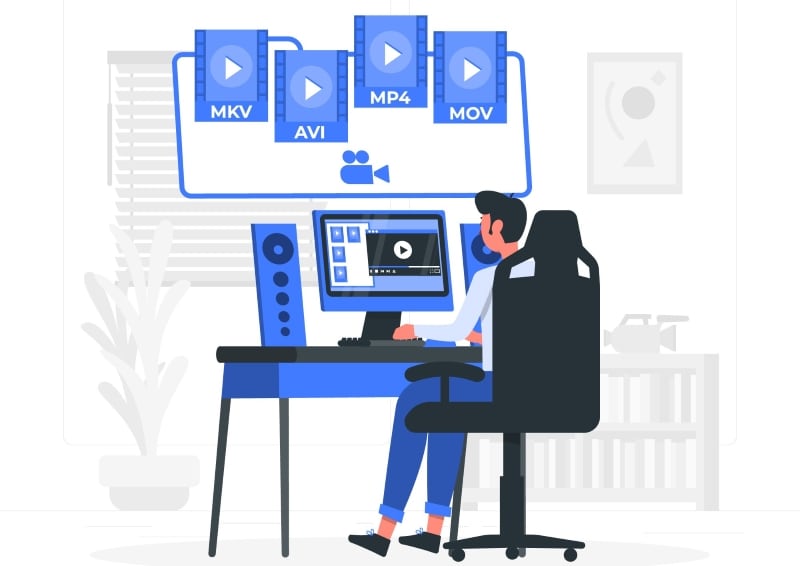
Conclusion
So you’ve seen how easy it can be to translate a video from Japanese to English. It’s up to you whether you will ask for the help of human translators, video editors, or AI video translators.
As you know, Virbo goes beyond being a basic Japanese to English video translator and converter. It takes the complexity out of translation, offering seamless and accurate results.
But remember, even the best AI translation can benefit from a human touch. Don’t be afraid to experiment and refine your translated video for the best outcome. With a little effort, you can bridge the language barrier and share your Japanese video content with the world.
Let’s say you’re a business owner or a content creator in Japan. If you want to broaden your horizons, you may need to translate videos from Japanese to English. This is because English is spoken globally. You can sell more, share knowledge, and connect with English speakers worldwide.
For streaming platforms, turning Japanese content into English is a ticket to reaching audiences all over the globe. And businesses using Japanese tech might need translated training videos for their remote workers.
Seeing this growing need, it’s clear you need effective video translation solutions. So, we’ve created a guide to help you choose the best method for each step, including using AI. Finding the right way to translate videos is important, so keep reading!

Part I. Completed Process To Translate Videos From Japanese to English
When you want to translate a video from Japanese to English, you can follow some general steps, no matter how you decide to do it. Let’s break down each step for you:
- Step 1: Video Transcription
Before you can translate, you need to understand what’s being said. So, the initial step is to do a video transcription. You can either hire professionals or use a Japanese-to-English video translator app to convert the spoken language to text.
Transcription captures all the Japanese dialogue, ensuring the English translation is spot-on. Having the text file lets you edit it, like shortening sentences or adjusting cultural references. This results in a smoother and more natural English video for you.
- Step 2: Translation
Once you have the transcript, you can translate the Japanese text into English. A good translation ensures the original message is accurately conveyed in the new language. It avoids any misunderstandings or misinterpretations for your English viewers. You have two options to do it. Both have strengths and weaknesses, so let’s see which suits your needs best.
- Professional Human Translation Services
When you want to translate a video from Japanese to English, a pro can make the sentences sound right for your audience. These professionals tweak the tone to be natural and engaging. If you go to translation agencies, they make sure the work is top-notch by going through strict editing and reviewing. However, human translation services cost more and take a bit more time than machine translation tools.
- Machine Translation Tools
Machine translation tools are fast and affordable. They can be a good option for short, simple videos where perfect accuracy isn’t critical. But it often struggles with complex language, cultural references, and humor.
- Step 3: Timing and Implementation
Let’s talk about making the Japanese to English video translation seamless. After translating, you want the words to match the original rhythm and pace of the speaker in the video. It keeps things feeling natural and engaging for you, the viewer. Plus, speakers use non-verbal cues like jokes, emotions, and pauses. Matching the translated text with these visual cues keeps the video’s meaning and impact intact.
How to do it? Professional workflows often use timecode, which gives each video frame a unique timestamp. It ensures super precise subtitle placement for that perfect synchronization. Some video editing tools even have “waveforms” to help visually line up subtitles with the spoken parts.

Here are several ways to add the translated Japanese text to your video:
- Subtitles
Subtitles are like on-screen translators for you. They show the English dialogue while the original Japanese audio goes on. It helps you understand if you get the visuals but not the language. The focus is on getting the main point across and sometimes making the sentences shorter for easier reading.
- Closed Captions
Like subtitles, closed captions (CC) are words shown on the screen. They go beyond spoken words, covering all the sounds you hear, like dialogue, music, and even background noises. The main goal is to help you, especially if you’re deaf or struggle with hearing. So, if you’re aiming for videos everyone can enjoy, try a video translator from Japanese to English with CC capabilities.
- Dubbing
Dubbing is a more intricate process where the original Japanese audio track is completely replaced. Voice actors step in to record the translated script in English. They try to sync up their words with the lip movements of the characters on screen. It makes it seem like the characters speak English right from the start, giving you a more immersive viewing experience.
- Voiceover
In this method, a narrator reads the translated script in English over the original Japanese audio. It’s often used in documentaries or educational videos when you need more info beyond just the dialogue.
- Step 4: Final Review and Approval
Alright, so you’re at the last step now. You’re giving the translated video a good check to ensure everything’s spot-on – accurate, consistent, and top-notch quality. It means looking out for any problems in the translation, timing, or how you choose to do it. Once you give the thumbs up to the final version, you’ve got a smooth and effective English video ready for your audience.
You might find the previous steps tedious and time-consuming. But what if you could translate your video from Japanese to English in minutes? That way, you could reach new markets and expand your influence faster. AI video translators like Wondershare Virbo can help you spread your work, passions, and stories to a global audience. Read on to learn more.
Part II. Virbo: Realistic AI Japanese to English Video Translator
You’re excited about your new product, but your explainer video feels like it’s only speaking to half the world. You know the potential exists, but the language barrier holds you back. Or perhaps you’ve captured stunning footage from your recent trip to Kyoto, but sharing it with your followers feels like a lost cause.
Here’s the deal: you don’t have to stick to a small crowd.

Get Started Online Free Download
Virbo uses the latest AI tech to automatically translate, dub voice, and add synced subtitles to your Japanese video. This app is simple to use and can translate video content into over 20 languages. Virbo translates Japanese to English videos in a few minutes – all free for videos under 2 minutes!
Here’s what makes Virbo stand out:
- Precise Lip-sync: Say goodbye to awkward, out-of-sync translations. Virbo AI video translator ensures the translated dialogue seamlessly matches the speaker’s lip movements and facial expressions, creating a natural and engaging experience (still in beta, but getting better every day!).
- AI Cloning Voices: Add engagement with Virbo’s AI-cloned voices that capture the essence of human speech. Choose from a range of natural-sounding voices that express the right emotions and add personality to your content.
- Soundtrack Reserved: Don’t lose the original soundtrack that sets the mood. Virbo allows you to keep it intact, enhancing its impact even in different languages.
- Versatile Compatibility: Virbo works across various platforms, including Windows, iOS, and Android. You can even use it online for ultimate flexibility.
- Affordable Excellence: Experience the power of AI video translation without breaking the bank. Virbo offers high-quality solutions at affordable prices, making them accessible to everyone.
Part III. How To Translate Japanese to English Video Using Virbo Automatically
Using Virbo AI video translator can help you be more productive. Here’s how to translate a video in Japanese to English online for free:
- Step 1: Go to Virbo AI video translator online from your browser for quick access. You can also download the app for your desktop. Once you’ve chosen your access point, sign in using your existing Google, Facebook, email, Apple, or Twitter account.
Get Started Online Free Download
- Step 2: Choose and upload your Japanese video file from your local storage. Ensure the video is between 10 seconds to 5 minutes long and in MP4 or MOV format, up to 500 MB for optimal processing.

- Step 3: Specify Japanese as the Original video language and English as the desired Target language.
- Step 4: Virbo offers Advanced Settings to customize the translated view result. Toggle on the Lip-sync, Subtitle, and Proofread video script switches to enable them when needed.

- Step 5: Click Translate this video to start the translation process once everything is set.
- Step 6: Wait a few moments while Virbo performs video transcription. Review the text and edit if needed.

- Step 7: Click Translate video to proceed, then the video will go to the queue.

- Step 8: After completion, you can preview the translated video before downloading the final English version.
Part IV. How To Achieve the Best Video Translation Results?
You can’t always translate a video from Japanese to English without a few difficulties. Here are some ways to make the process easier for you:
Divide the Script Into Manageable Chunks
Break down the script into smaller sections like sentences, phrases, or even shorter segments depending on the video’s pace and complexity. It allows for more precise timing adjustments later.
Use a “Shadowing” Technique
As you watch the video, read the translated text out loud. Adjust the subtitle timing to match how you naturally speak. Doing this makes the flow feel more natural for you and the viewers.
Test and Refine
Now that you’ve set the timing for the subtitles, it’s time to put them to the test with your target audience. This step is important because it helps you catch any timing problems, awkward phrasing, or cultural differences that might have slipped through during editing.
Listen to what your audience says, and then use that feedback to tweak the subtitles. Your goal is to make sure they’re clear, short, and match the audience’s culture.
AI for Pre-Translation Tasks
Take advantage of AI tools for speech-to-text conversion and automatic subtitle generation. It can save time, but always proofread for accuracy and natural flow.
File Compatibility
Ensure your chosen translation service or tool supports the format of your video file. The common formats include MP4, MOV, and AVI.

Conclusion
So you’ve seen how easy it can be to translate a video from Japanese to English. It’s up to you whether you will ask for the help of human translators, video editors, or AI video translators.
As you know, Virbo goes beyond being a basic Japanese to English video translator and converter. It takes the complexity out of translation, offering seamless and accurate results.
But remember, even the best AI translation can benefit from a human touch. Don’t be afraid to experiment and refine your translated video for the best outcome. With a little effort, you can bridge the language barrier and share your Japanese video content with the world.
SRT Subtitle Translation: Tools and Techniques
In a multilingual world, the single largest barrier to effective communication is language. Nobody knows all the languages spoken around the world, do they? What to do to break this barrier of communication? In the domain of audiovisual content such as on YouTube, we leverage subtitles to break that barrier. How? By using online SRT translation software to auto translate SRT file into the language of our audience. Sounds fascinating? Read on to learn how to translate SRT online yourself!
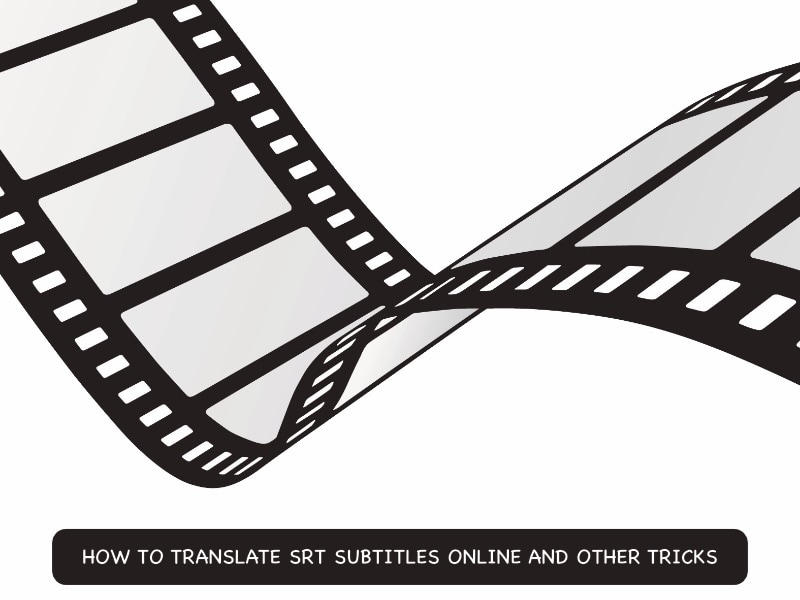
Part 1: Why Is Using Online SRT Translation Tools Recommended?
You might be wondering why you would translate SRT subtitles online when you can do them yourself. The simple answer is that you cannot translate SRT subtitles online and reach a global audience by yourself. You might know one language, or two, or maybe five or ten. Twenty? Okay, you might know 20 languages. According to UNESCO World Atlas of Languages (UNESCO WAL) there are over 7000 languages in use. You certainly do not need to know or translate into those many.
To reach a global audience of 195 countries (193 recognized by UN) you only need a handful, and you might be able to get by with what you know. But, how about using an online SRT file translator to get the job done faster, more accurately, and in a greater number of languages than you can? This way, you free up your time to do more important tasks than being a translator!
- Online SRT translation is fast.
- Online SRT translation is efficient and timesaving.
- Online SRT translation is accurate (depending on chosen tool).
- Online SRT translation translates into many more languages than we know.
- Online SRT translation allows us to reach a larger audience.
- Content engagement shoots up due to wider availability of subtitles.
- User retention rate increases as a larger number of users can connect with your content due to subtitles in their native language.
Part 2: Top Online SRT Translation Tools
What are the top SRT translation tools online available to us today? Let’s dive into them and give you a gist and their pros and cons!
2.1: Translate Subtitles
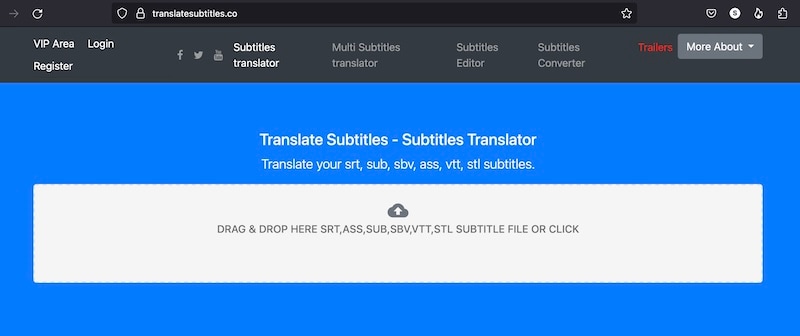
One of the best online SRT translate tools, Translate Subtitles is an online SRT translator that is easy and intuitive to use. We are classifying the features into Pros and Cons.
Pros
- Supports 6 subtitle formats (srt, sub, sbv, ass, vtt, and stl) for translation.
- Can translate into all languages that Google Translate supports.
- Can translate 20 files at once.
- Free to use.
Cons
- Uses Google Translate, so it is as good or bad as Google Translate.
- Supports file size up to 1 MB only.
2.2: Subtitles Translator
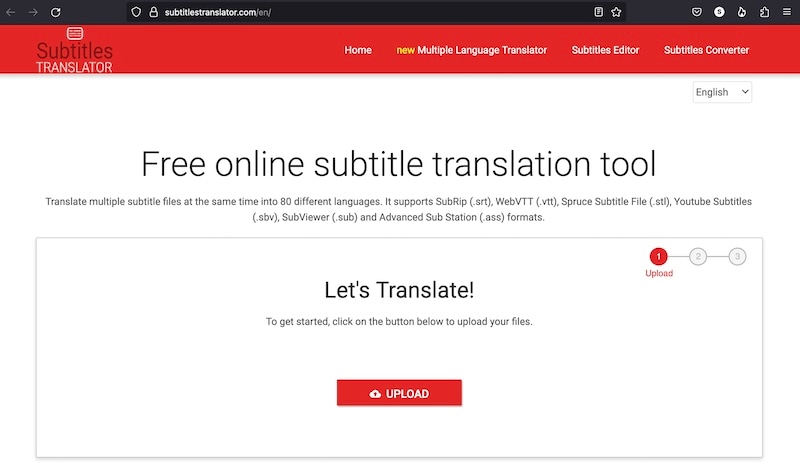
Subtitles Translator is another powerful online subtitle translator you can use, with features similar to Translate Subtitles.
Pros
- Can translate 20 files at once.
- Supports the same 6 file formats as Translate Subtitles (srt, sub, sbv, ass, vtt, and stl).
- Provides a subtitle converter to convert between subtitle formats.
- Provides a subtitle editor you could use to make changes.
Cons
- Maximum file size supported is 1 MB only.
2.3: Maestra AI
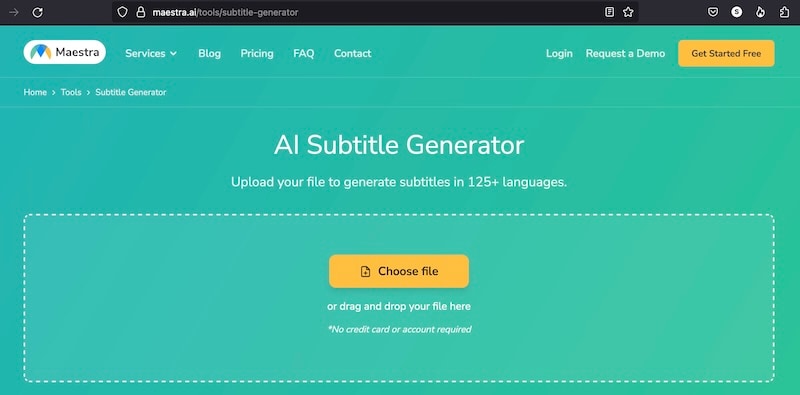
Maestra is one of the most powerful subtitle translators online. Its feature list will have you drooling over it, but it does not come without its cons. Here are the pros and cons of Maestra.
Pros
- Support for over 125 languages.
- Easy to use and fast subtitle translator.
- Subtitle editor available to make changes.
Cons
- Pricing could be a turn-off for some users.
2.4: VEED.IO
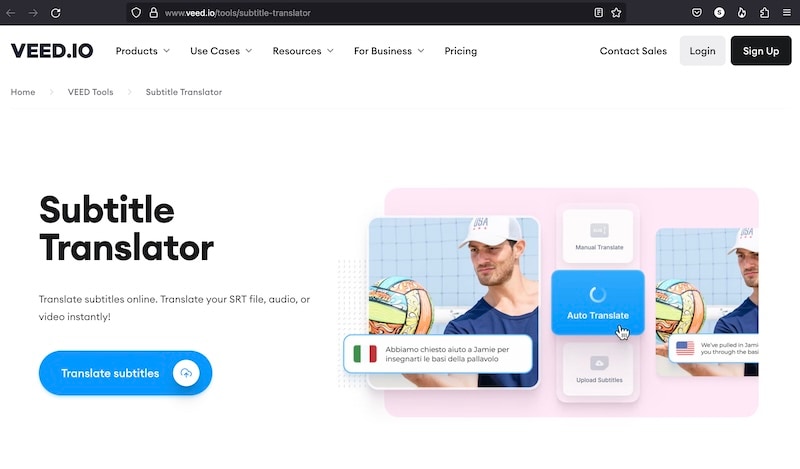
VEED.IO is a popular subtitle translation online software that offers better accuracy than some of the other competitors as its unique selling point.
Pros
- Better accuracy than some other online SRT translation tools.
- Subtitle can be downloaded in a different subtitle format.
- Direct upload of files from YouTube is possible.
Cons
- Can be expensive to use owing to features you might not need.
2.5: Media.io
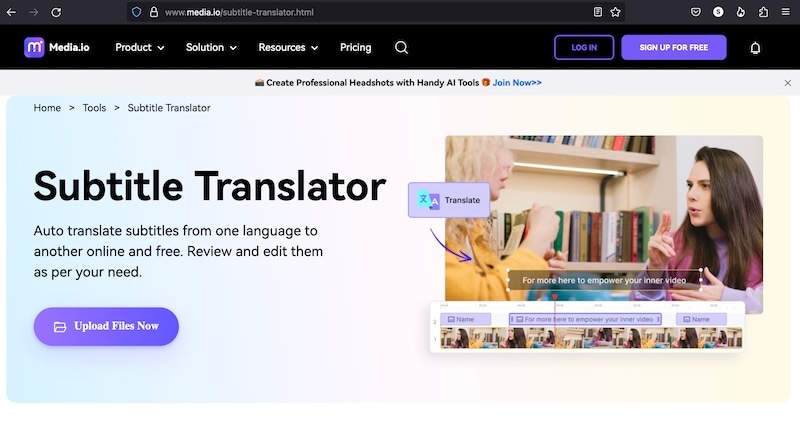
Media.io is a product from Wondershare Company, which means that it has all the hallmarks every other Wondershare product comes with – legendary ease of use married with unparalleled power. What can Media.io do for you?
Pros
- Media.io supports 127 languages.
- Translated subtitles match the audio/ video automatically.
- Rich subtitle editor offers the best way to edit, customize and stylize subtitles.
- Included video editor offers a full spectrum of useful features such as the ability to add music, elements, logos, voiceovers, etc.
- Powered by AI (artificial intelligence) for leading accuracy.
Cons
- Free version limited to a file size of 250 MB.
2.6: smartcat
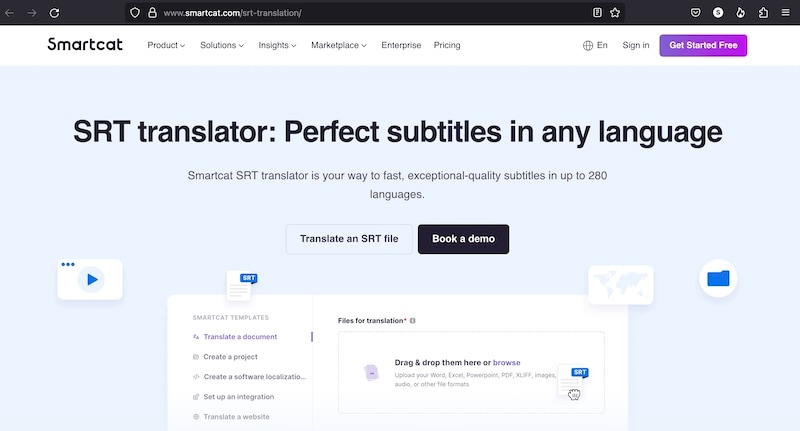
Smartcat deserves a special mention in the online srt translation space due to its support for 280 languages. Yes, you read that right. It supports those many languages! Here are some pros and cons of Smartcat.
Pros
- Support for over 280 languages!
- Over 90% accuracy rate.
- Ability to collaborate with people to edit subtitles.
- Sharing is possible.
Cons
- There is an intriguing word count limit of 150,000 words per year for translation.
Part 3: How To Choose The Best Tool To Translate SRT File
Now, with all those options looking rather equally viable, how do you choose? Do you just pick one and go? Well, yes and no. If you just want to see how things work, any of those options is going to serve as a good measure. However, when you want to translate SRT subtitles online in a more professional way wherein your reputation and image are on the line, you want the best of the best. Here is how to choose just the right online subtitle translation tool for you.
3.1: Ease of Use
How easy is an online subtitle translation software to use? Most online SRT translation tools boast a simple, 3-step process. You will not find much variance here, because it is just a simple upload, translate, and download process.
3.2: Editing Features
Online SRT subtitles translator software may provide you with editing features. These editing features can be used to differentiate between products and are worth looking into. If one online editor does not have something that the other offers, clearly the other is your tool, other factors notwithstanding.
3.3: Format Support
Most software to translate SRT online support a number of subtitle formats. However, one or two might not support the format you want to use, so check the number of formats supported before using an online tool to translate SRT subtitles.
3.4: Translation Accuracy
When translating subtitles online, you want an online SRT translation tool with the highest possible accuracy to have a reasonable surety with respect to the quality of the translated subtitles. You do not want to appear immature and unprofessional due to poor quality of subtitles, do you?
3.5: Data Privacy
Now this one is KEY. No matter how good that online SRT translator AI tool is, you do not want to use it for your subtitles if that tool does not afford you a rock-solid data privacy. When you upload SRT to an online SRT translation software, what does that software do with your file afterwards? Does it store it forever? How is the communication between your device and their server happening? These are important questions that need clear answers for any user, but especially so when translating sensitive content or proprietary content.
Part 4: How To Use An Online SRT Translation Tool To Translate SRT Online
Let’s get down to using an online SRT translation tool to translate an SRT file online. We will use Media.io for the purpose.
Step 1: Launch the online subtitle translator tool and click Subtitles from the sidebar.
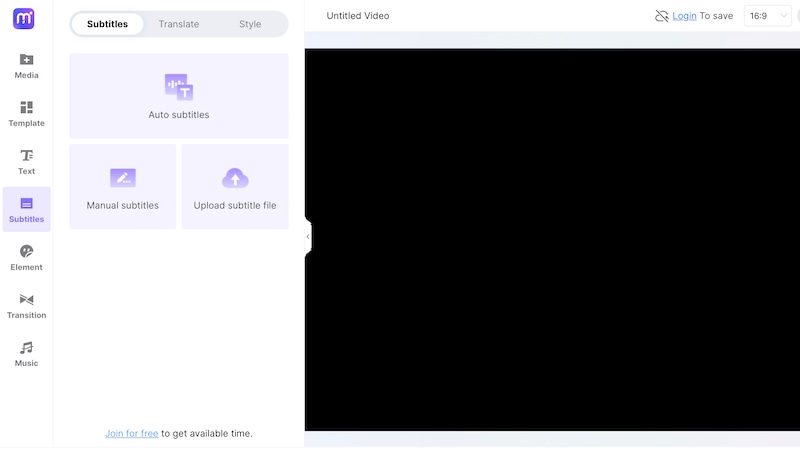
Step 2: Click Upload Subtitle File and upload your subtitles. Subtitles will be loaded and shown.
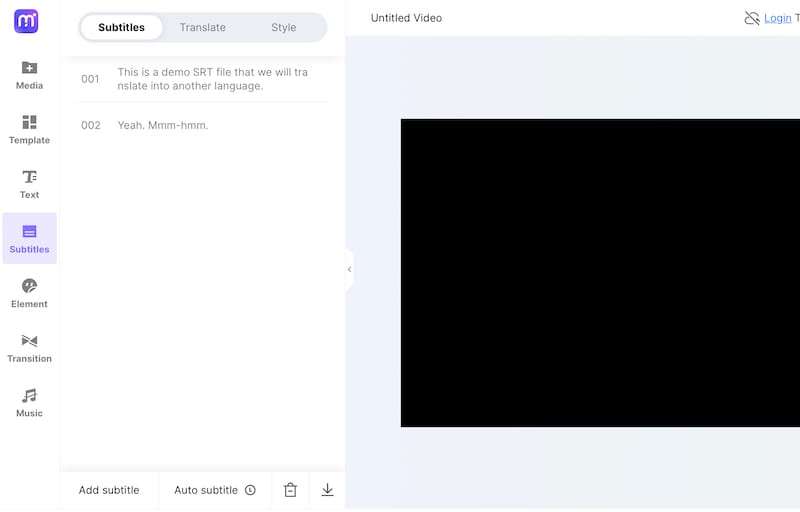
Step 3: In the tab above, click Translate and select a target language from the dropdown and click Translate.
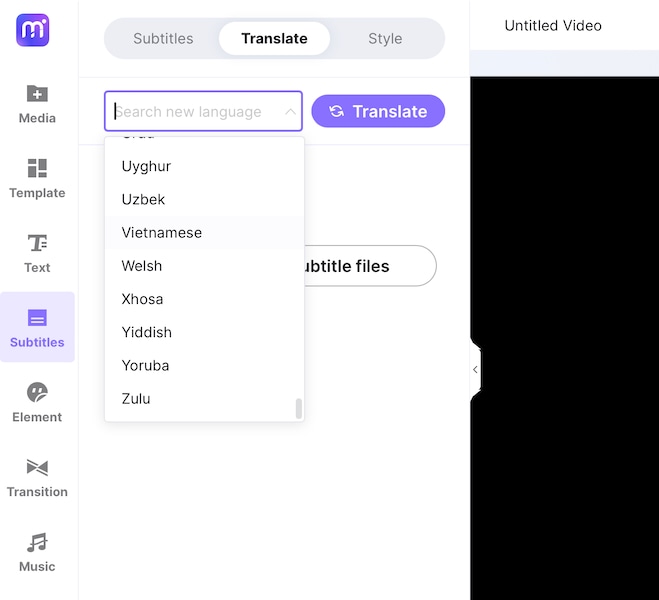
Step 4: When the subtitles are translated, download the subtitles in the format you want. That’s it!
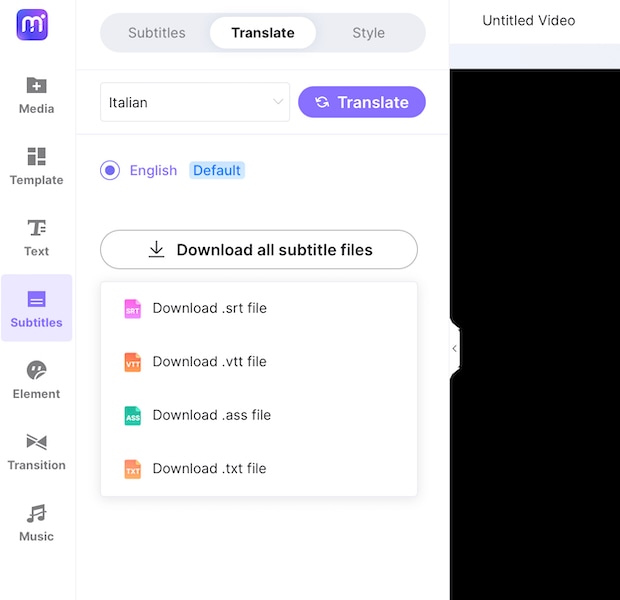
Bonus Tip: Translate Video To Any Language Of Your Choice With Virbo
Apart from subtitles, what about videos? Can we translate videos online easily? Yes! There is just the tool for that, too!
Wondershare Virbo: The Ultimate Online Video Translator
Wondershare Virbo was designed and developed with you in mind. It is by far the easiest way to translate videos online. Here are the steps to use Wondershare Virbo to translate your videos online.
Translate Video Online Free Download
Step 1: Go to the Wondershare Virbo Online website.
Sign In with Google, Facebook, Twitter or Apple ID, or use your existing Wondershare Account. Else, create a new Wondershare Account and proceed.
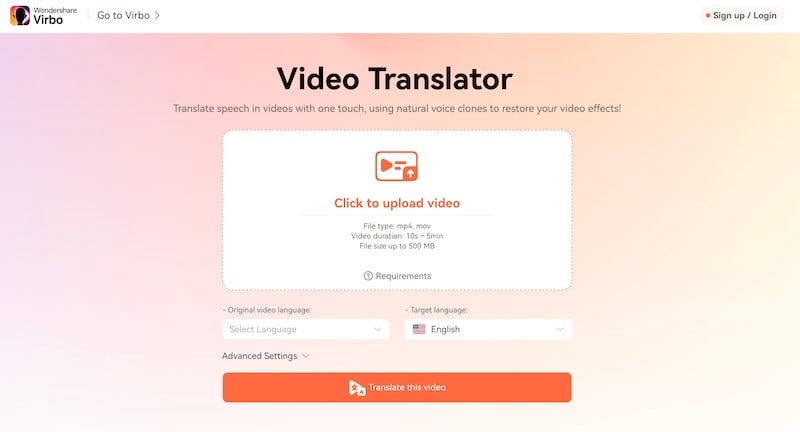
Step 2: Add a video to translate. Then, choose the original video language and the target translation language, that is, the new language you want to translate your video to.
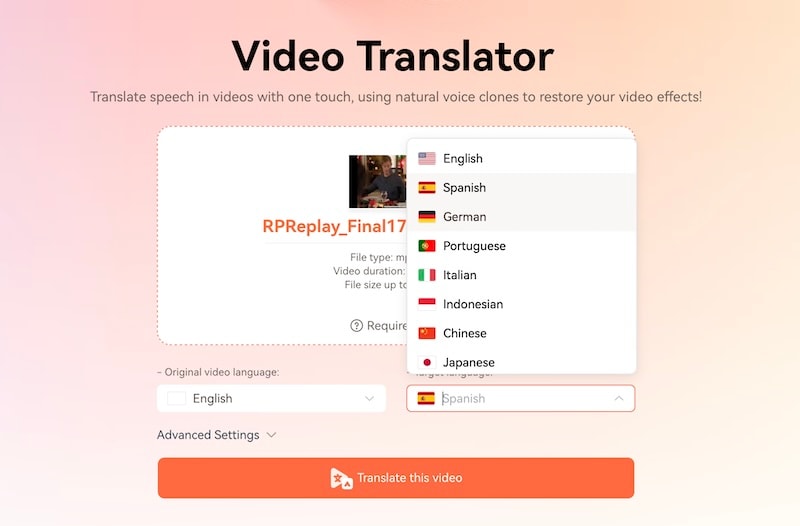
Step 3: Click Translate. When the process is over, save the translated video to a location of your choice.
ADVANCED FEATURES
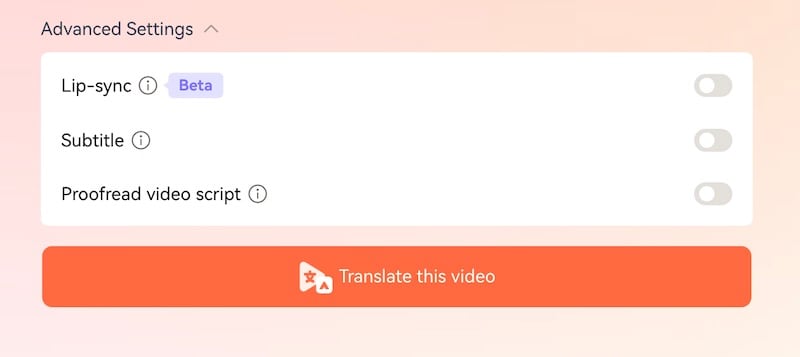
Wondershare Virbo comes with 3 advanced features:
- You can use the power of AI to create perfectly lip-synced videos in line with the target language. Try it to believe it!
- Enable Subtitle option to burn the translated subtitles directly into the video. This should only be done if there are no subtitles already present in the video.
- Enabling Proofread Video Script option automatically parses and proofreads the video script for more accurate video translation.
Translate Video Online Free Download
Conclusion
Gone are the days when you had to make separate videos for every language you wanted your videos to be in and had to hire linguists to proofread and check your subtitle files in case you were using subtitles in different languages for your videos. Today, you can auto translate subtitles online using any of the freely available online SRT translation tools. However, this guide shows you how to select the right tool for you, and as bonus, gives you an easy-to-use tool to translate videos into any language easily!
Step-by-Step Guide: How to Translate TikTok Videos
TikTok has become a global sensation in today’s digital age. Their short-form video content has transformed the social media landscape. It has become one of the most popular social media platforms, with millions of users worldwide.
To maximize engagement reach, creators can now translate TikTok videos into different languages and expand their audience. If you are curious, we’ll delve into how to translate TikTok videos in this article.

Part 1. Why Do Creators and Brands Need to Translate TikTok Videos
TikTok’s translation feature helps users understand content in different languages. It translates captions and text from one language to another. Hence, everyone can enjoy the videos. To use the translation feature, tap “See translation” at the bottom of the screen. The app will translate the captions into your device’s language.
Here are more reasons why it’s important:
Reaching New Markets
TikTok translatebreaks language barriers. Helping you reach new audiences who may not understand your content otherwise. This feature makes it easier to connect with them. And leading to more engagement and potential leads.
Enhancing Rankings
Translating content broadens its reach, leading to increased engagement and popularity. This feature, in turn, can improve its ranking on search engines. Higher rankings mean more visibility and traffic. This means more conversions, especially if the video is embedded on your website.
Improving TikTok Advertising
When running ads, the translation tool allows targeting audiences in other languages. This feature eliminates language barriers and expands your ad reach. Potential increasing ad effectiveness and reaching a wider audience.
Boosting Sales Conversions
Adding captions to videos increases impressions by over 55%. As a business owner, captions help. With the translation tool, more people from different backgrounds can understand your content. This feature will enhance the viewing experience. Potential in boosting their chances of buying your product.
Part 2. How to Translate TikTok Videos to English with Auto-Translate Feature
In 2022, TikTok introduced translation tools to break down language barriers. Making content more accessible to all users. The main components of TikTok’s translation tool include captions and description translation, auto-generated video captions, and sticker translation.
1. Captions and description translation
This feature allows users to auto-translate captions and descriptions. Therefore, users can enjoy TikTok videos in languages other than their own. For instance, if you want totranslate a TikTok video to Englishfrom Japanese captions. You can follow these steps:
- Step 1. Go to your profile, then click the three strips at the top of the screen.

- Step 2. Open Settings and Privacy

- Step 3. Go to Language under the Content & Activity section

- Step 4. Toggle on Always Show Translations

Once selected, you can translate captions and descriptions of videos in different languages. You can click “See Translation” when watching TikTok’s videos.
2. Auto-generated video captions
This feature allows viewers to enable closed captions for videos they’re watching. And eliminate the need for creators to add captions manually. The auto-generated captions appear above the video creator’s name on the For You Page. Captions will appear once you tap them.

3. Sticker Translation
This feature enables the translation of text stickers. Stickers are the text overlays you see while watching a video. With this feature, you can understand the text stickers that are using other languages.
These translation features facilitate communication across language barriers. Accessing content from around the world becomes easier. Regardless of one’s language or geographical location. You can go to this link for more detailed information about auto-translate tools.
Part 3. How to Translate TikTok Videos into Any Language with AI Video Translator
TikTok’s auto-translation feature has a limited range of languages. They only allow auto-translation within captions. Wondershare Virbo offers a solution to enhance your experience beyond the platform’s features. TikTok video translator by Wondershare Virbo is a tool that enables users to make their TikTok videos speak in different languages. By using this tool, you can also add subtitles to the videos.
Here is the step-by-step guide how to translate TikTok video using Virbo’s AI Video Translator tool:
- Step 1. Go to Wondershare Virbo official website and select Generate AI Video Online.

Get Started Online Free Download
- Step 2. Create an account or log-in

- Step 3. Once you land on the Virbo homepage, go to Video Translate

- Step 4. Upload the video you want to translate
In the Video Translator interface, upload the video file you want to translate. Then, select the original video language and the preferred target language. You can also activate the Lip Sync feature to ensure the accuracy of audio translation with the video’s lip movements.

- Step 5. Click “Translate this video” to start the translation process. Virbo AI will seamlessly translate the audio and synchronize it with the video. Depending on the video’s length and complexity, the process may take some time to complete.
Conclusion
In conclusion, using Virbo’s Translator tool to translate TikTok videos has many benefits. It helps creators reach more people and engage with diverse audiences worldwide. As we look to the future of making content on TikTok, tools like Virbo’s Translator tool will be super necessary. They’ll help break down language barriers and make content accessible to everyone.
TikTok has become a global sensation in today’s digital age. Their short-form video content has transformed the social media landscape. It has become one of the most popular social media platforms, with millions of users worldwide.
To maximize engagement reach, creators can now translate TikTok videos into different languages and expand their audience. If you are curious, we’ll delve into how to translate TikTok videos in this article.

Part 1. Why Do Creators and Brands Need to Translate TikTok Videos
TikTok’s translation feature helps users understand content in different languages. It translates captions and text from one language to another. Hence, everyone can enjoy the videos. To use the translation feature, tap “See translation” at the bottom of the screen. The app will translate the captions into your device’s language.
Here are more reasons why it’s important:
Reaching New Markets
TikTok translatebreaks language barriers. Helping you reach new audiences who may not understand your content otherwise. This feature makes it easier to connect with them. And leading to more engagement and potential leads.
Enhancing Rankings
Translating content broadens its reach, leading to increased engagement and popularity. This feature, in turn, can improve its ranking on search engines. Higher rankings mean more visibility and traffic. This means more conversions, especially if the video is embedded on your website.
Improving TikTok Advertising
When running ads, the translation tool allows targeting audiences in other languages. This feature eliminates language barriers and expands your ad reach. Potential increasing ad effectiveness and reaching a wider audience.
Boosting Sales Conversions
Adding captions to videos increases impressions by over 55%. As a business owner, captions help. With the translation tool, more people from different backgrounds can understand your content. This feature will enhance the viewing experience. Potential in boosting their chances of buying your product.
Part 2. How to Translate TikTok Videos to English with Auto-Translate Feature
In 2022, TikTok introduced translation tools to break down language barriers. Making content more accessible to all users. The main components of TikTok’s translation tool include captions and description translation, auto-generated video captions, and sticker translation.
1. Captions and description translation
This feature allows users to auto-translate captions and descriptions. Therefore, users can enjoy TikTok videos in languages other than their own. For instance, if you want totranslate a TikTok video to Englishfrom Japanese captions. You can follow these steps:
- Step 1. Go to your profile, then click the three strips at the top of the screen.

- Step 2. Open Settings and Privacy

- Step 3. Go to Language under the Content & Activity section

- Step 4. Toggle on Always Show Translations

Once selected, you can translate captions and descriptions of videos in different languages. You can click “See Translation” when watching TikTok’s videos.
2. Auto-generated video captions
This feature allows viewers to enable closed captions for videos they’re watching. And eliminate the need for creators to add captions manually. The auto-generated captions appear above the video creator’s name on the For You Page. Captions will appear once you tap them.

3. Sticker Translation
This feature enables the translation of text stickers. Stickers are the text overlays you see while watching a video. With this feature, you can understand the text stickers that are using other languages.
These translation features facilitate communication across language barriers. Accessing content from around the world becomes easier. Regardless of one’s language or geographical location. You can go to this link for more detailed information about auto-translate tools.
Part 3. How to Translate TikTok Videos into Any Language with AI Video Translator
TikTok’s auto-translation feature has a limited range of languages. They only allow auto-translation within captions. Wondershare Virbo offers a solution to enhance your experience beyond the platform’s features. TikTok video translator by Wondershare Virbo is a tool that enables users to make their TikTok videos speak in different languages. By using this tool, you can also add subtitles to the videos.
Here is the step-by-step guide how to translate TikTok video using Virbo’s AI Video Translator tool:
- Step 1. Go to Wondershare Virbo official website and select Generate AI Video Online.

Get Started Online Free Download
- Step 2. Create an account or log-in

- Step 3. Once you land on the Virbo homepage, go to Video Translate

- Step 4. Upload the video you want to translate
In the Video Translator interface, upload the video file you want to translate. Then, select the original video language and the preferred target language. You can also activate the Lip Sync feature to ensure the accuracy of audio translation with the video’s lip movements.

- Step 5. Click “Translate this video” to start the translation process. Virbo AI will seamlessly translate the audio and synchronize it with the video. Depending on the video’s length and complexity, the process may take some time to complete.
Conclusion
In conclusion, using Virbo’s Translator tool to translate TikTok videos has many benefits. It helps creators reach more people and engage with diverse audiences worldwide. As we look to the future of making content on TikTok, tools like Virbo’s Translator tool will be super necessary. They’ll help break down language barriers and make content accessible to everyone.
Top 10 Hindi Video Translators with Step-by-Step Guidance
Whether you’re a YouTube content creator or a Bollywood movie fan, it is entirely possible to translate Hindi videos to English. We live in an era with advanced AI and features that would entirely blow your mind.
So, in this blog, we’re covering the best 10 Hindi video translators with step-by-step guidance on how you can do it. But first, we will recommend a solution that would make Hindi translation for all devices easier.
Part 1. Most Recommended Hindi Video Translator for all Devices - Virbo
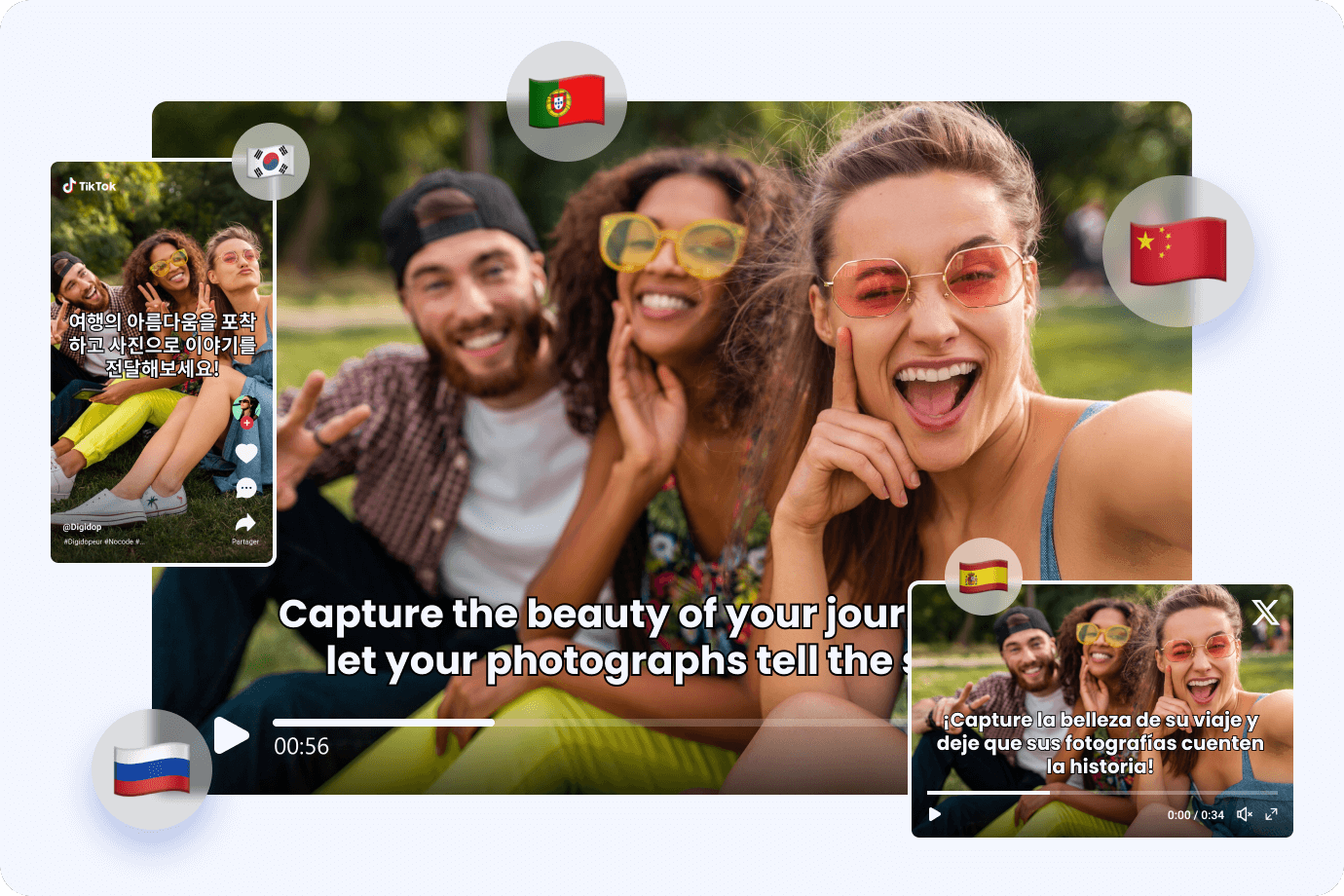
Wondershare Virbo is an AI video generator that covers multinational AI avatars, a plethora of natural voices, royalty-free assets, templates, and cross-platform support. So, whether you want a Hindi national spokesperson for your YouTube channel for media use, or you would like a Chinese national, there’s a choice for everyone.
All you need to have is text that you would like to be converted, and Virbo, with its extreme AI knowledge, would easily get the job done for you. So, let’s talk about some of the features that Virbo offers.
Steps to Translate Video English to Hindi
Vibro allows you to generate and translate videos for free, as long as you don’t reach your free quote. So, the first step is to sign up on Virbo for free. Go to the Official App Website and then select “Login”
- You can simply Login with Google or Create an account, based on your preference. And if you already have an account, then you can just login regularly.
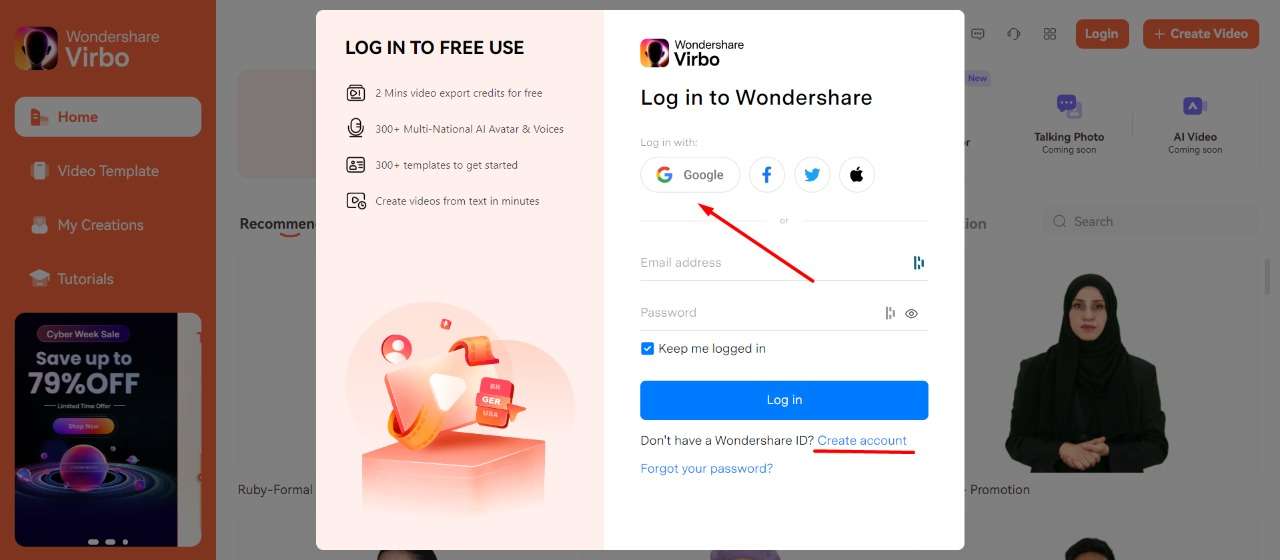
- Now you will reach the application page, and in the top right corner you will see the “Video Translator” tool. Click on that.
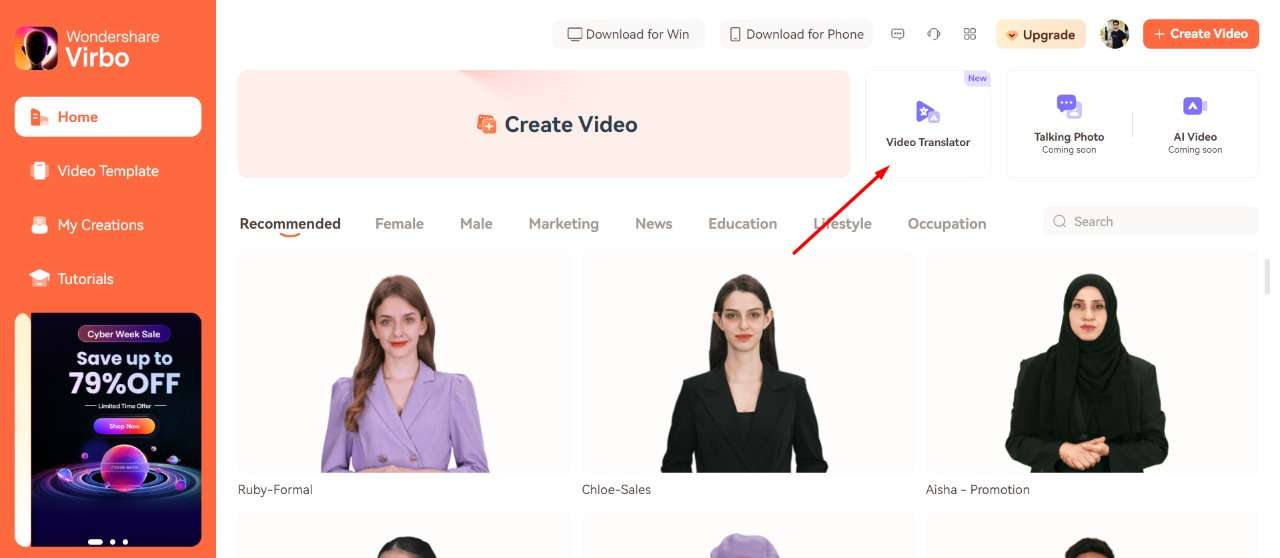
- The app will take you to the next tab. You can also download Virbo on your PC or mobile. Once you are on the Virbo app page, you can upload a video. The free version allows you to translate a video that is up to 2 minutes and 200MB.
Click to upload a video, select the original video language, which is English in our case, and select the target language to “Hindi.” Once you upload the file, select “Translate this video.”
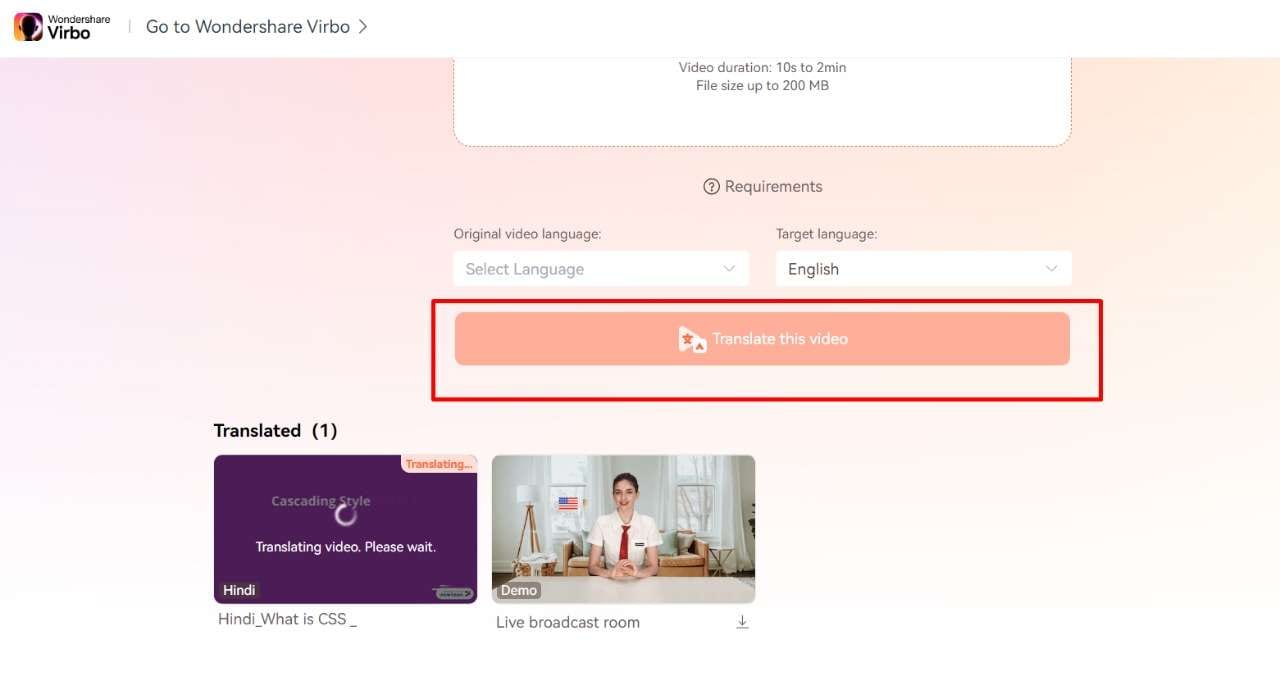
- Wait for the file to be translated, and you will have your own translated video. Now, you can enjoy translating as many videos as you like.
Key Features of Virbo Video Translator
1. AI Avatar

It is the era of the virtual avatars and Virbo absolutely delivers. It generates a virtual avatar for you that you can use to translate Hindi scripts to English with ease. Whether you are a news channel, a YouTuber, or just want to present something from Hindi to English, then using Virbo will be your best bet.
There are more than 300+ real human voices that are natural, you can engage with a broader audience, and the ethnicity choices are more, so no one is left out. All in all, the AI avatar feature of Virbo is revolutionary, making it one of the best Hindi video translators right now.
2. AI Voice
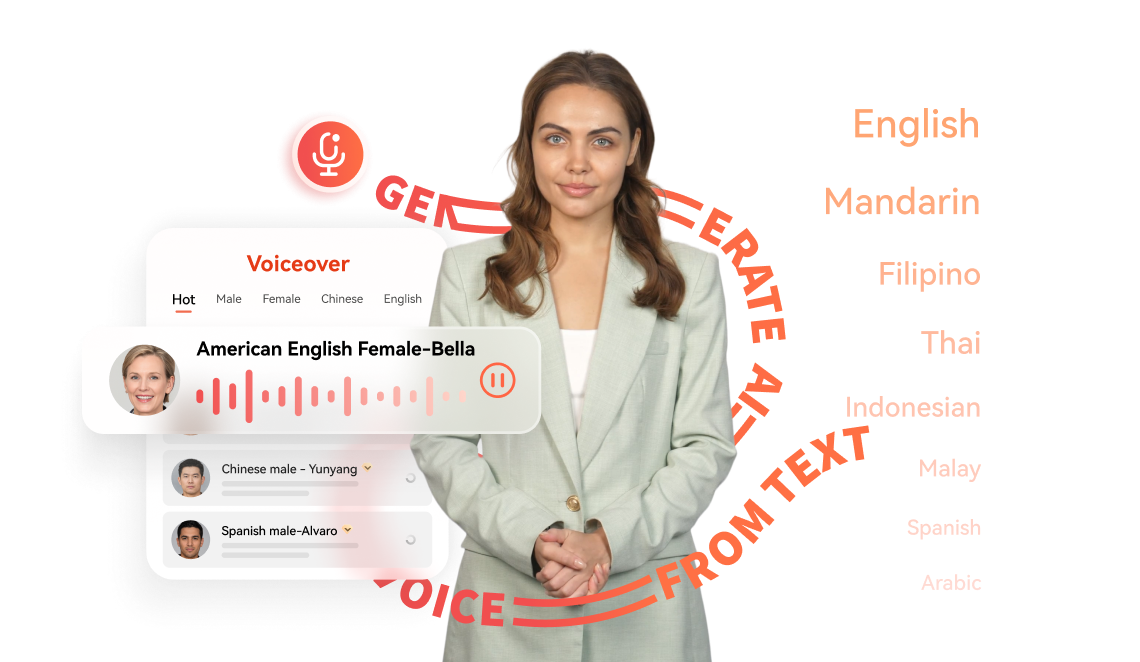
AI Voice is another strong point that goes hand in hand with AI Avatars. If you want to translate videos from Hindi to English and vice versa, you can use AI Voice from Virbo to create educational videos, marketing campaigns, customer interactions, and a lot more. The voice is human-like and uses the latest and greatest AI language models to do so.
3. AI Script Generator
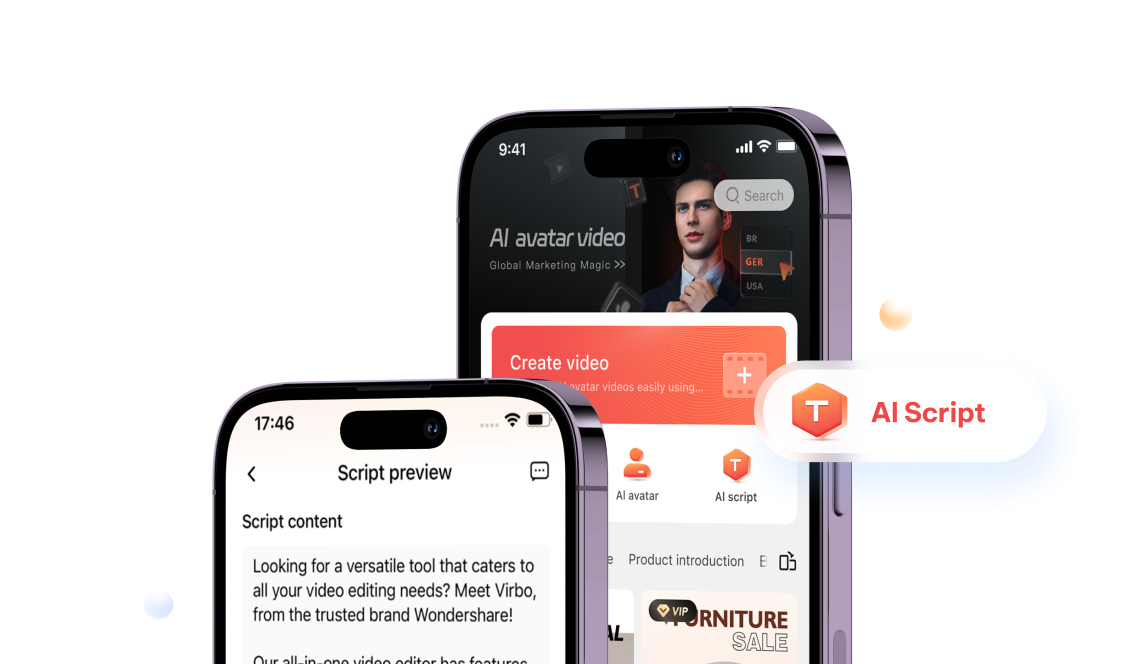
But what if you want to automate the whole process? Well, Vibro also has an AI script generator tool that enables you to use ChatGPT to get AI written scripts. But how will this help? Let’s say you are an educational institution who wants to teach your students some subject in Hindi. With Virbo, you can generate a script and then translate that script into Hindi, making education great again!
Pros of Virbo
- Amazing end results with AI voice and avatar generation tool.
- Video editing features are also included.
- Realistic and natural characters.
- All AI features make the video creation process simpler and effective.
- Powerful translation tool to make realistic videos in various languages.
- Comes with a video translator too that is simple to use.
Cons of Virbo
- Sometimes, there’s a slight lag.
Get Started Online Free Download
Part 2. Alternative 5 tools to translate Hindi video to English [Online]
1. Veed.io
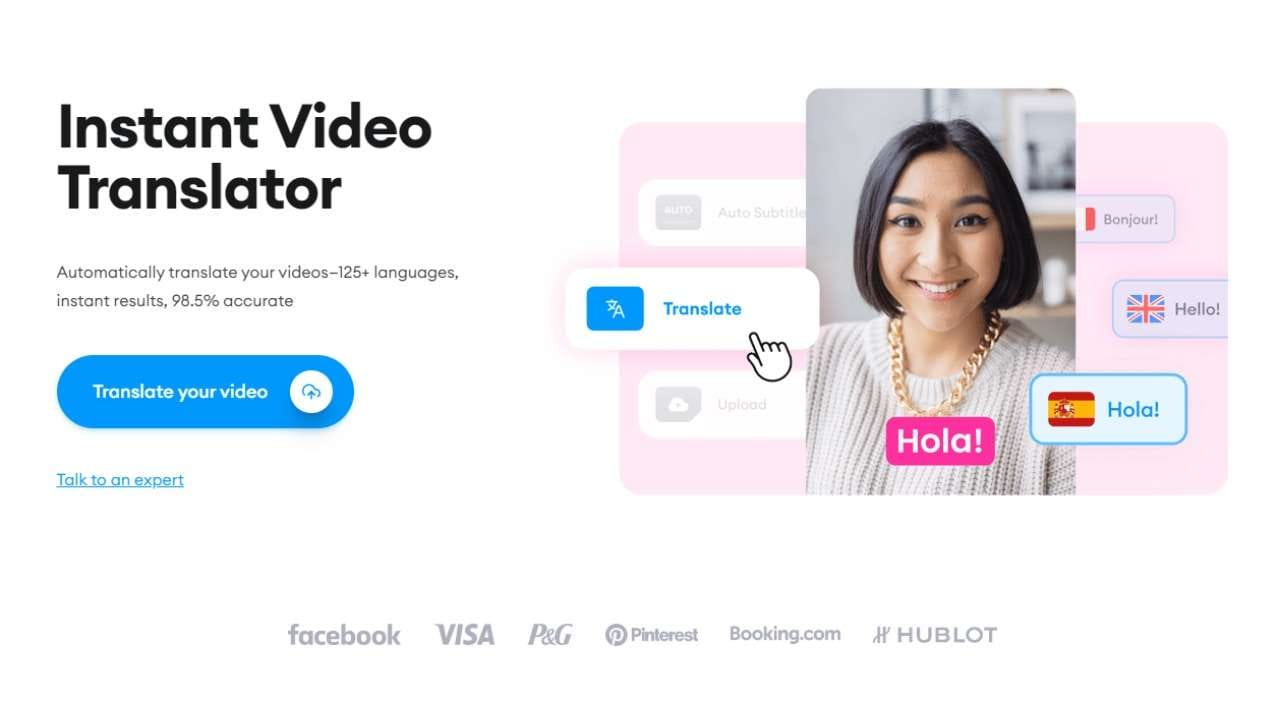
While there are a lot of Hindi-to-English translation tools on the market, you won’t find something like Veed . The reason is simple: it translates videos in 125+ languages with over 98.5% accuracy. Some of the biggest brands like Facebook, VISA, P&G, and Pinterest have also used Veed for their brand, which means Veed has an extremely good qualification for video translation.
Now, let’s talk about its features:
1. Download subtitles for efficient content repurposing:
While many video translation tools offer good features, Veed takes it to the next level by allowing you to download and edit subtitles according to your needs. You can also hard code or burn your subtitles to your videos permanently.
2. Accurate translations:
With over 98% accuracy in subtitles and translation, Veed can also be considered a great substitute for Google Translate and other tools. It is a great tool that also acts as a movie translator in Hindi apps, making it the best online app for translating movies.
Generate Engaging
AI Video in Minutes!
Easily convert text into professional spokesperson videos in over 120+ voices & languages in minutes.
Generate AI Video Free Generate AI Video Now

2. Kapwing
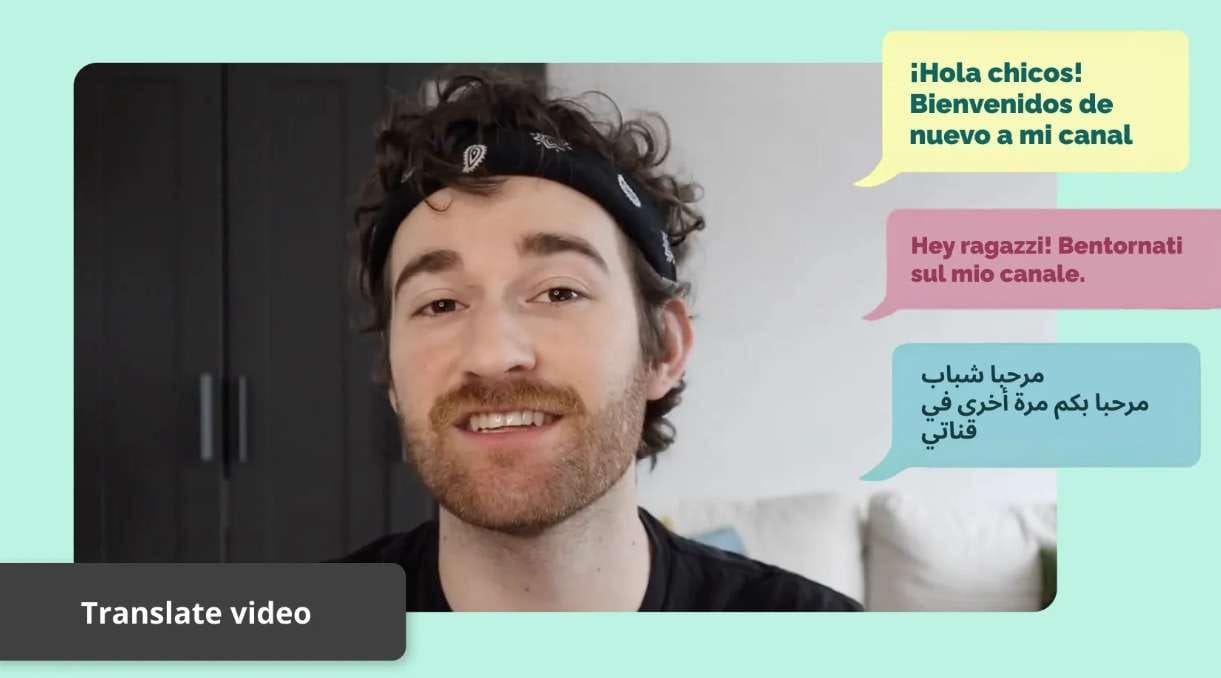
In the world of instant video translation tools, Kapwing takes the cake for being one of the most versatile tools out there. You can use the AI-powered tool in just a couple of minutes with a few clicks, and your work will be done easily.
You can instantly translate videos to and from 70+ languages, which saves hours of manually translating videos to reach a global audience. Here are some of the key features of Kapwing:
1. Automatic translations for videos, audio, and text:
Being an all-in-one translation tool, Kapwing can translate any audio file and even convert videos to text. It uses powerful AI subtitles, transcripts, and text-to-speech generation, so all aspects of content can be translated easily.
2. 70+ languages support:
With Kapwing, you can not only do Hindi video translation but it goes beyond that. With over 70+ languages, there’s a lot of flexibility in terms of which languages you can edit.
3. Flixier
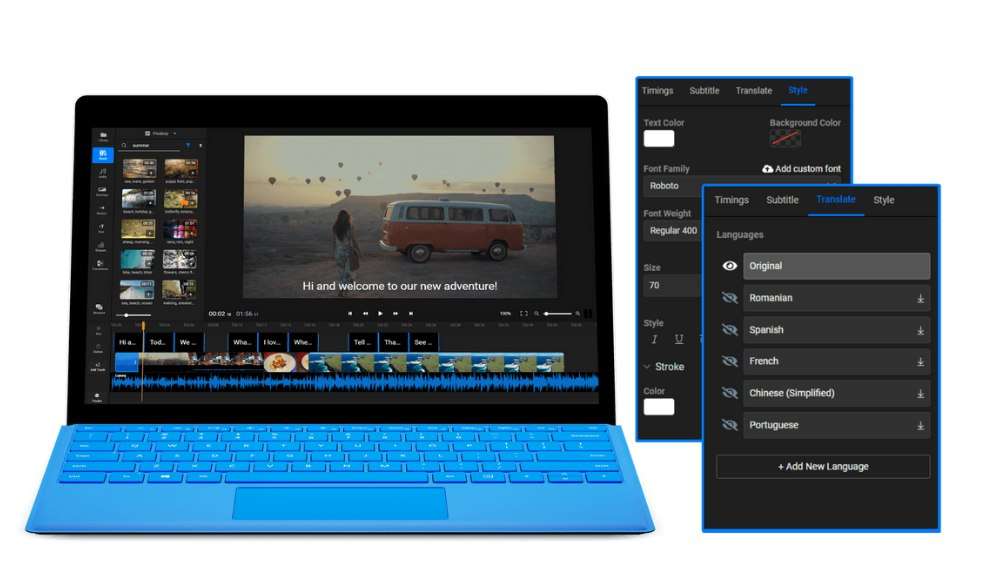
Flixier is one of the easiest software to use if you want a fast video language translator. While it doesn’t have a lot of language options, with 30 well-built languages, you can still get your content transformed into another language.
Flixier is also one of the few translators that allows subtitles translation in Hindi. However, there’s even more. The software is easy to use and doesn’t even require you to have an account unless you decide to go premium. Here are some of the features that it offers:
1. Video translation in browser:
With Flixier, you can easily translate your videos right within your browser. All you need is a good internet connection and a computer that would work well. The translation process is made even simpler because you don’t even have to make an account to use the software.
2. Free to use:
One of the biggest benefits of using Flixier is that it is a free video translator. Of course, as you use it more, you are going to have to buy the premium version, but if you want to try the software or get some simple projects done, then the free version will cater to your needs.
4. Rask AI

Rask AI is the future of video translations. It features over 130 languages, allowing the videos to resonate with viewers all around the globe. Moreover, it uses the latest AI tech to make sure that you get the best possible results every time you use its service.
But the user experience is where Rask AI takes the place of being one of the best Hindi-to-English video translators. All you need is to first upload your video or movie, select a language, and then translate according to your language choice. You will get the best possible result in this case.
Here are some of Rask AI’s features that make it so popular:
1. Automation made easier:
With Rask AI, automation is made easier as you don’t have to worry about taking out all that time to hire a translator, and even then, there’s a good chance of error. The AI-powered technology makes sure that the translation is done efficiently and effectively.
2. Language translation:
Rask AI is specifically made to translate language in video content. This way, no matter what business you have, you can reach a broader audience. The platform is easy to use, and anyone can learn it within a matter of minutes.
5. Typito
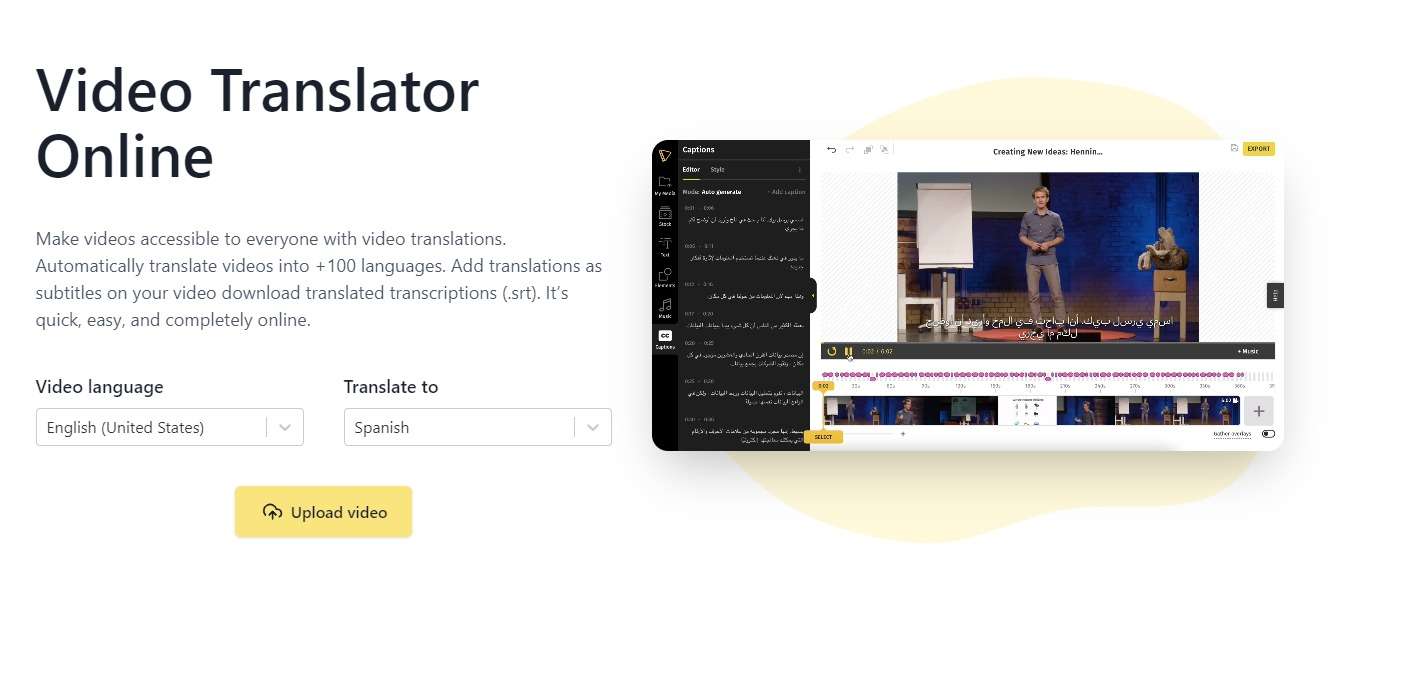
Typito offers one of the best Hindi video-to-English translations, but that’s not all. More than 500,000+ marketers, news agencies, business owners, and influencers are already using Typito to grow their audience to the next level.
Using this software is pretty simple. All you need to do is select the video language of your choice and select the desired translation language. As you upload the video, you need to wait for a few minutes for the online software to process. After some time, you are going to get your newly translated video right on your computer.
Here are some of the key features offered by Typito:
1. Translate into multiple languages:
Typito makes it easier for you to translate videos into multiple languages. The tool is designed to save you hours of your time while you simply get the most professionally translated video in a plethora of languages.
2. Translate YouTube videos:
One of the most popular features of Typito is that it allows you to translate your content far beyond what YouTube has to offer. It can burn your translated subtitles to appear the way you want. Moreover, you can also plate the subtitles on the top or bottom of your video.
3. Translate video to text:
While there are a lot of text-to-video translators, Typito goes beyond the regular stereotypes and also provides video-to-text translation with 95% accuracy. You can also click on the generated transcription to edit any words or phrases to your liking.
Part 3. Alternative 5 tools for Hindi video to English translation [Download]
1. Filmora
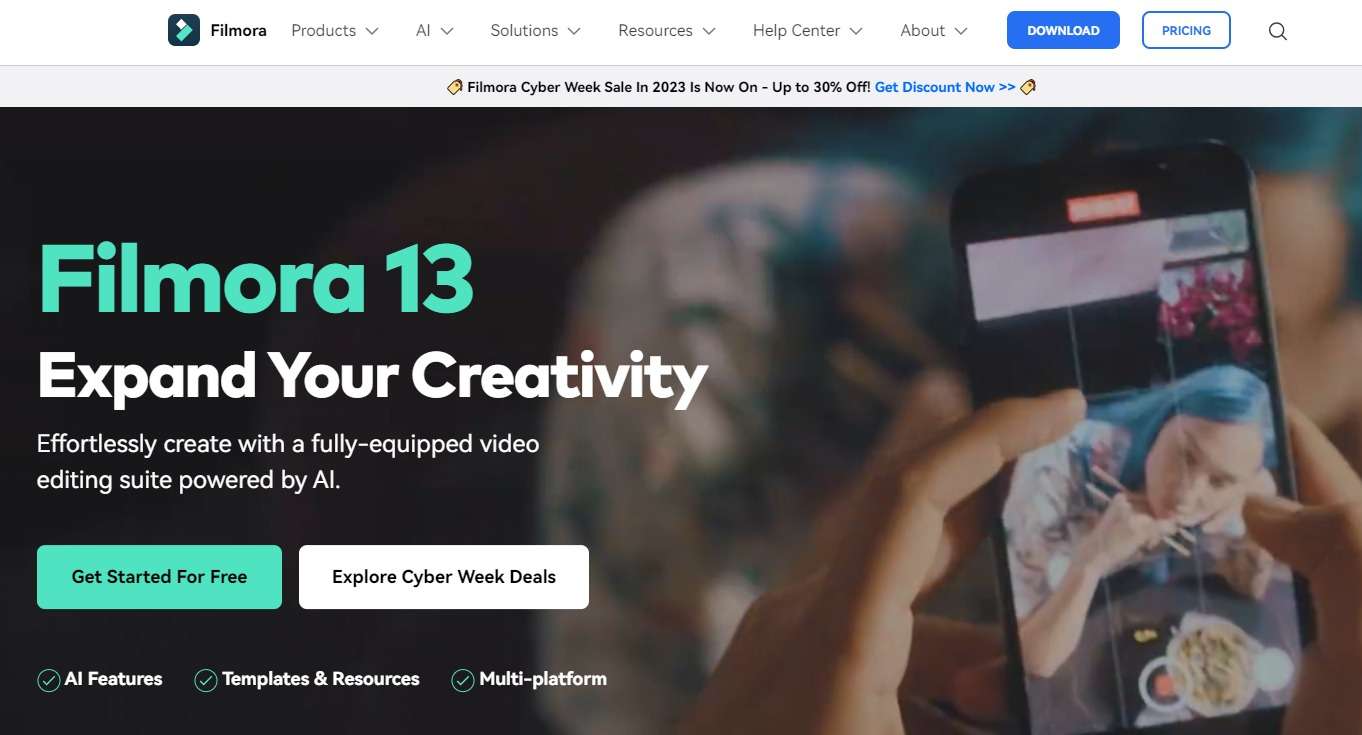
While Filmora has a broader focus, it can do free translations for your videos. You can use the video speech-to-text tool to make your videos more readable. The 1-click translator can translate your video into English, Chinese, Hindi, Spanish, French, Korean, Arabic, Russian, and over 26 languages.
If you want to emphasize or edit the subtitles, you can also use the built-in text editor to change the font, style, color, and everything.
1. Strong speech-to-text feature:
Fillmore has one of the strongest text-to-speech features that it uses to translate videos. Imagine having a video editor that does everything else for you. Filmora aims to be exactly that tool.
2. All-in-one editing tool:
The biggest benefit of using Filmora by far is the fact that it is more than just video translation software. It is mainly a video editing software with a plethora of AI tools that help in various parts of video production.
2. Streamr by VidToon
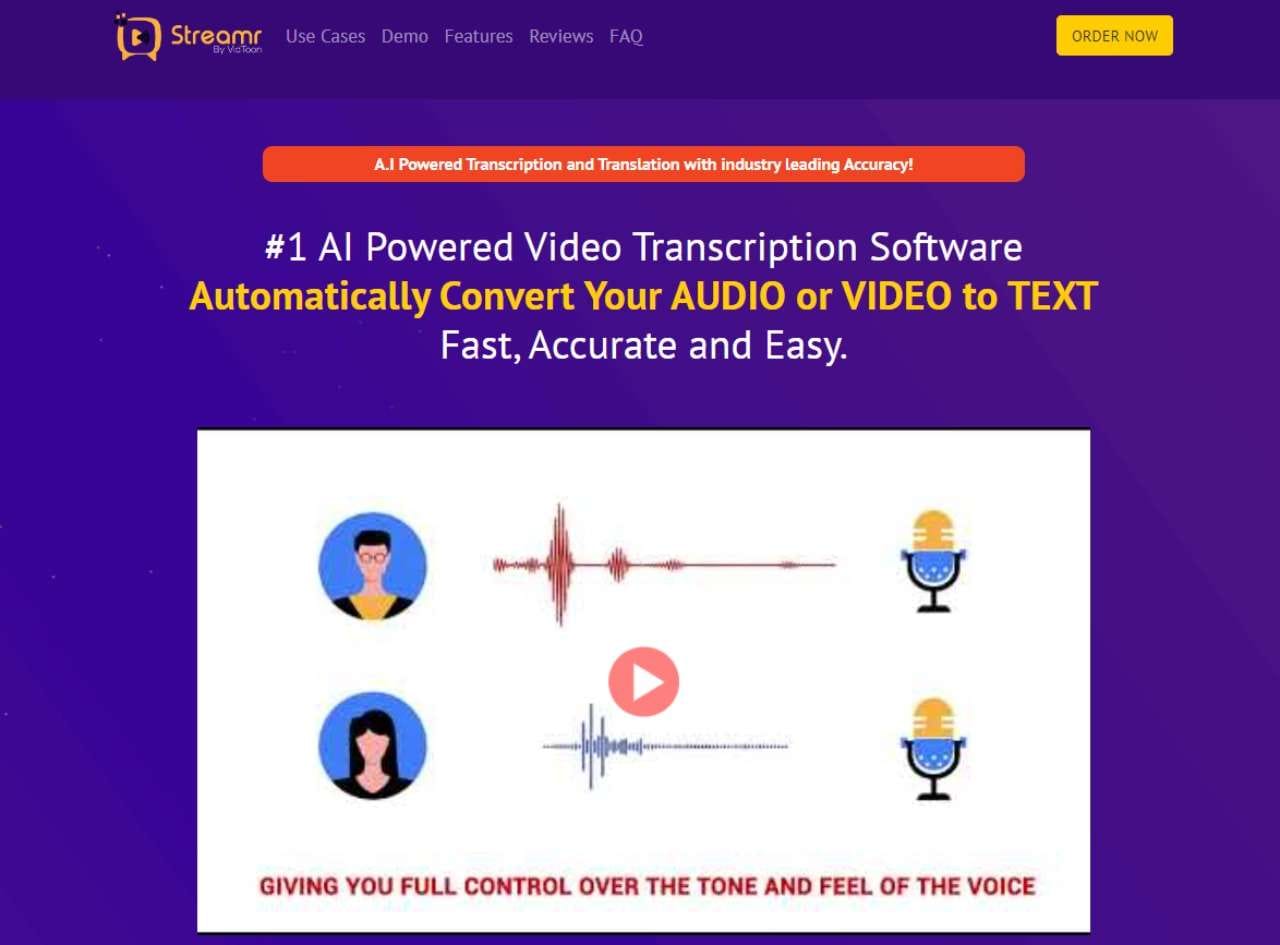
Streamr is a great tool to automatically convert your audio or video to text and beyond. However, it is a tool that is more focused on subtitles and gives you control over the text side of things.
So, if you ever want a video or audio to be converted into Hindi or English, then Streamr might be the best tool for you. It gives you so much control over the subtitle side of things that you would be amazed.
So, let’s discover some of these features:
1. Surge your conversions:
One of the best ways to tap the untapped markets is by using a tool like Streamr. It allows you to tap into the foreign market and multiply your video exposure by 75% all over the world.
2. Fully automated video:
With Streamr, you can make a fully automated video translation, Video Transcription, Audio Translation, Audio Transcription Software.
3. Vidscribe
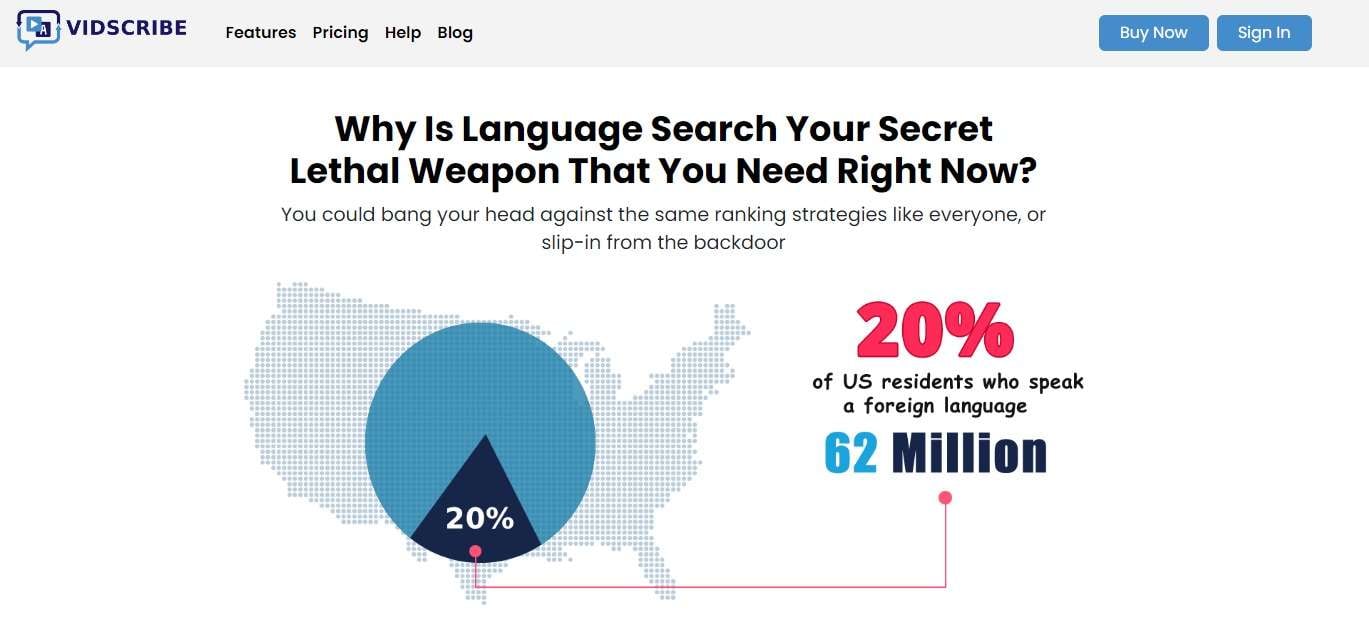
Vidscribe is an all-in-one tool with a plethora of features. However, one of its main features is to translate videos from 100s of languages, which is one of the best ways to reach a global audience.
Vidscribe can be downloaded to your PC, but it is a paid tool with features that make translation easier and more effective. Here are some of the features it offers:
1. Global reach:
Vidscribe is ideal for YouTube channels, blogs, and other media companies that want to take over the digital world. It has some of the most advanced tools to translate and then track those metrics. If you want a Hindi-to-English or English-to-Hindi translator, then Vidscribe would be ideal.
2. Money back guarantee:
With VidScribe, you also get a 30-day money-back guarantee. You should know that most online tools don’t work on this model. Since VidScribe is more of a translation and SEO tool, it provides you with a lot of flexibility and options.
4. VSCAT

But if you’re looking to translate Hindi to English and vice versa, then a classic tool like VSCAT would be your friend. It is a powerful tool that lets you translate and automatically create video subtitles in multiple languages.
Yes, it does support Hindi, and it does its job perfectly. Here are some of the key features of VSCAT:
1. Advance technology:
VSCAT uses advanced technology like OpenAI’s whisper to help you in the translation of these videos. It is a tool that has proven to be a popular translator time and again. Moreover, with VSCAT, you can enable yourself to provide content that would convert.
2. Easy-to-use:
While VSCAT looks like it’s complex, it’s fairly simple to use. All the features are well-laid out, and you can make any settings you want according to your liking. This means that aside from doing the translation, you can also customize the software according to your liking.
5. Speechify
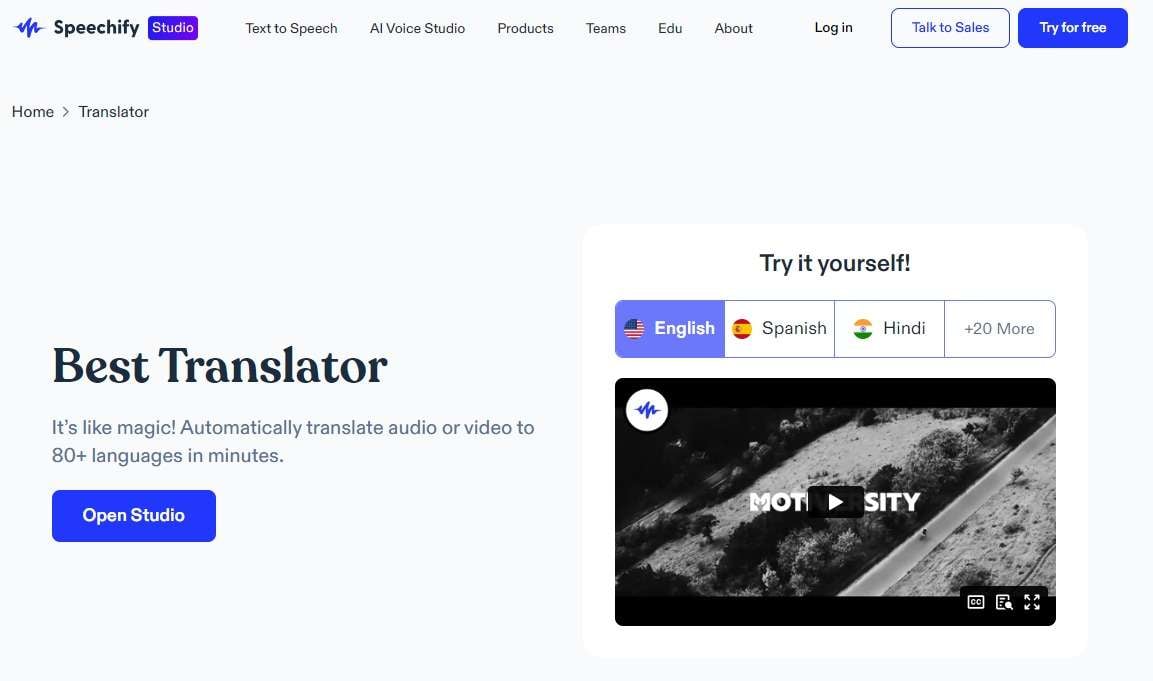
One of the best translation tools for Hindi to English is Speechify . While the software doesn’t have an app on Windows, you can use it on both Android and iOS. For Windows users, they can easily leverage the Chrome extension or the online tool to translate videos.
Here are a few features that it provides:
1. 80+ language support:
Speechify works like magic. It supports 80+ languages that you can use to automatically translate video or audio. There’s no need for expensive processes or employees, and you can instantly get the desired results according to your liking.
2. Realistic AI voices:
The software does give you extremely good AI voices. They not only sound like humans but everything from the accent and the dialect to everything; you can rely on Speechify to deliver a pristine quality of voiceovers.
Part 4. F.A.Q about Hindi Video Translator
01 How can I translate a Hindi video to English?
To translate a Hindi video into English, you need AI-centric video translation software. We have mentioned a lot of tools above. If you are looking for the perfect tool to translate Hindi to English or English to Hindi, then you should use a tool like Veed.io or Virbo for easy and efficient translation.
02 How to convert Hindi text to English
One of the best ways to convert Hindi text to English is by using a tool like Streamr or Kapwing. Both have great built-in features that allow for easy Hindi text-to-English conversion. Whether you are looking for a Hindi video to English translation tool or something that would translate text, you can find a variety of tools that would help you in achieving this. We have also mentioned them based on the features and expertise of each tool and how they work.
03 How can I translate video words?
To translate video words, you need to use a video-to-text translation tool. In the description above, we have mentioned many tools that can help you achieve the same. If you want to translate Hindi video to English or simply the words, you should aim for a tool that is specifically going to specialize in translating words.
Easily convert text into professional spokesperson videos in over 120+ voices & languages in minutes.
Generate AI Video Free Generate AI Video Now

2. Kapwing

In the world of instant video translation tools, Kapwing takes the cake for being one of the most versatile tools out there. You can use the AI-powered tool in just a couple of minutes with a few clicks, and your work will be done easily.
You can instantly translate videos to and from 70+ languages, which saves hours of manually translating videos to reach a global audience. Here are some of the key features of Kapwing:
1. Automatic translations for videos, audio, and text:
Being an all-in-one translation tool, Kapwing can translate any audio file and even convert videos to text. It uses powerful AI subtitles, transcripts, and text-to-speech generation, so all aspects of content can be translated easily.
2. 70+ languages support:
With Kapwing, you can not only do Hindi video translation but it goes beyond that. With over 70+ languages, there’s a lot of flexibility in terms of which languages you can edit.
3. Flixier

Flixier is one of the easiest software to use if you want a fast video language translator. While it doesn’t have a lot of language options, with 30 well-built languages, you can still get your content transformed into another language.
Flixier is also one of the few translators that allows subtitles translation in Hindi. However, there’s even more. The software is easy to use and doesn’t even require you to have an account unless you decide to go premium. Here are some of the features that it offers:
1. Video translation in browser:
With Flixier, you can easily translate your videos right within your browser. All you need is a good internet connection and a computer that would work well. The translation process is made even simpler because you don’t even have to make an account to use the software.
2. Free to use:
One of the biggest benefits of using Flixier is that it is a free video translator. Of course, as you use it more, you are going to have to buy the premium version, but if you want to try the software or get some simple projects done, then the free version will cater to your needs.
4. Rask AI

Rask AI is the future of video translations. It features over 130 languages, allowing the videos to resonate with viewers all around the globe. Moreover, it uses the latest AI tech to make sure that you get the best possible results every time you use its service.
But the user experience is where Rask AI takes the place of being one of the best Hindi-to-English video translators. All you need is to first upload your video or movie, select a language, and then translate according to your language choice. You will get the best possible result in this case.
Here are some of Rask AI’s features that make it so popular:
1. Automation made easier:
With Rask AI, automation is made easier as you don’t have to worry about taking out all that time to hire a translator, and even then, there’s a good chance of error. The AI-powered technology makes sure that the translation is done efficiently and effectively.
2. Language translation:
Rask AI is specifically made to translate language in video content. This way, no matter what business you have, you can reach a broader audience. The platform is easy to use, and anyone can learn it within a matter of minutes.
5. Typito

Typito offers one of the best Hindi video-to-English translations, but that’s not all. More than 500,000+ marketers, news agencies, business owners, and influencers are already using Typito to grow their audience to the next level.
Using this software is pretty simple. All you need to do is select the video language of your choice and select the desired translation language. As you upload the video, you need to wait for a few minutes for the online software to process. After some time, you are going to get your newly translated video right on your computer.
Here are some of the key features offered by Typito:
1. Translate into multiple languages:
Typito makes it easier for you to translate videos into multiple languages. The tool is designed to save you hours of your time while you simply get the most professionally translated video in a plethora of languages.
2. Translate YouTube videos:
One of the most popular features of Typito is that it allows you to translate your content far beyond what YouTube has to offer. It can burn your translated subtitles to appear the way you want. Moreover, you can also plate the subtitles on the top or bottom of your video.
3. Translate video to text:
While there are a lot of text-to-video translators, Typito goes beyond the regular stereotypes and also provides video-to-text translation with 95% accuracy. You can also click on the generated transcription to edit any words or phrases to your liking.
Part 3. Alternative 5 tools for Hindi video to English translation [Download]
1. Filmora

While Filmora has a broader focus, it can do free translations for your videos. You can use the video speech-to-text tool to make your videos more readable. The 1-click translator can translate your video into English, Chinese, Hindi, Spanish, French, Korean, Arabic, Russian, and over 26 languages.
If you want to emphasize or edit the subtitles, you can also use the built-in text editor to change the font, style, color, and everything.
1. Strong speech-to-text feature:
Fillmore has one of the strongest text-to-speech features that it uses to translate videos. Imagine having a video editor that does everything else for you. Filmora aims to be exactly that tool.
2. All-in-one editing tool:
The biggest benefit of using Filmora by far is the fact that it is more than just video translation software. It is mainly a video editing software with a plethora of AI tools that help in various parts of video production.
2. Streamr by VidToon

Streamr is a great tool to automatically convert your audio or video to text and beyond. However, it is a tool that is more focused on subtitles and gives you control over the text side of things.
So, if you ever want a video or audio to be converted into Hindi or English, then Streamr might be the best tool for you. It gives you so much control over the subtitle side of things that you would be amazed.
So, let’s discover some of these features:
1. Surge your conversions:
One of the best ways to tap the untapped markets is by using a tool like Streamr. It allows you to tap into the foreign market and multiply your video exposure by 75% all over the world.
2. Fully automated video:
With Streamr, you can make a fully automated video translation, Video Transcription, Audio Translation, Audio Transcription Software.
3. Vidscribe

Vidscribe is an all-in-one tool with a plethora of features. However, one of its main features is to translate videos from 100s of languages, which is one of the best ways to reach a global audience.
Vidscribe can be downloaded to your PC, but it is a paid tool with features that make translation easier and more effective. Here are some of the features it offers:
1. Global reach:
Vidscribe is ideal for YouTube channels, blogs, and other media companies that want to take over the digital world. It has some of the most advanced tools to translate and then track those metrics. If you want a Hindi-to-English or English-to-Hindi translator, then Vidscribe would be ideal.
2. Money back guarantee:
With VidScribe, you also get a 30-day money-back guarantee. You should know that most online tools don’t work on this model. Since VidScribe is more of a translation and SEO tool, it provides you with a lot of flexibility and options.
4. VSCAT

But if you’re looking to translate Hindi to English and vice versa, then a classic tool like VSCAT would be your friend. It is a powerful tool that lets you translate and automatically create video subtitles in multiple languages.
Yes, it does support Hindi, and it does its job perfectly. Here are some of the key features of VSCAT:
1. Advance technology:
VSCAT uses advanced technology like OpenAI’s whisper to help you in the translation of these videos. It is a tool that has proven to be a popular translator time and again. Moreover, with VSCAT, you can enable yourself to provide content that would convert.
2. Easy-to-use:
While VSCAT looks like it’s complex, it’s fairly simple to use. All the features are well-laid out, and you can make any settings you want according to your liking. This means that aside from doing the translation, you can also customize the software according to your liking.
5. Speechify

One of the best translation tools for Hindi to English is Speechify . While the software doesn’t have an app on Windows, you can use it on both Android and iOS. For Windows users, they can easily leverage the Chrome extension or the online tool to translate videos.
Here are a few features that it provides:
1. 80+ language support:
Speechify works like magic. It supports 80+ languages that you can use to automatically translate video or audio. There’s no need for expensive processes or employees, and you can instantly get the desired results according to your liking.
2. Realistic AI voices:
The software does give you extremely good AI voices. They not only sound like humans but everything from the accent and the dialect to everything; you can rely on Speechify to deliver a pristine quality of voiceovers.
Part 4. F.A.Q about Hindi Video Translator
01 How can I translate a Hindi video to English?
To translate a Hindi video into English, you need AI-centric video translation software. We have mentioned a lot of tools above. If you are looking for the perfect tool to translate Hindi to English or English to Hindi, then you should use a tool like Veed.io or Virbo for easy and efficient translation.
02 How to convert Hindi text to English
One of the best ways to convert Hindi text to English is by using a tool like Streamr or Kapwing. Both have great built-in features that allow for easy Hindi text-to-English conversion. Whether you are looking for a Hindi video to English translation tool or something that would translate text, you can find a variety of tools that would help you in achieving this. We have also mentioned them based on the features and expertise of each tool and how they work.
03 How can I translate video words?
To translate video words, you need to use a video-to-text translation tool. In the description above, we have mentioned many tools that can help you achieve the same. If you want to translate Hindi video to English or simply the words, you should aim for a tool that is specifically going to specialize in translating words.
Revealing Translation Methods: Netflix Subtitle Software Comprehensive Guide
Subtitle translation on Netflix plays a pivotal role in enhancing the global viewership experience. With Netflix’s expansive reach across diverse linguistic demographics, accurate Netflix translation ensures accessibility and inclusivity for audiences worldwide. Subtitles not only cater to non-native speakers but also serve the needs of the deaf and hard-of-hearing community fostering a more comprehensive viewing environment.
The importance of precise translation lies in preserving the nuances of dialogue, cultural references, and context, thus maintaining the authenticity of the content. To address this, various software tools and methods, including Netflix subtitles translator, are employed, leveraging technology and human expertise to ensure high-quality translations. In this article, we will explore various software and methods for translating subtitles on Netflix effectively.
Part 1: Difficulties Lies in Netflix Subtitle Translation

Translating subtitles for Netflix is a multifaceted endeavor that extends beyond linguistic conversion. It entails delicately navigating cultural nuances, balancing precision with sensitivity, and encapsulating dialogue essence within tight constraints.
As Netflix expands globally, high-quality translation Netflix becomes crucial for a seamless viewing experience. To deepen comprehension, here are the complexities inherent in Netflix subtitle translation:
● Preserving Cultural Nuances
This involves accurately conveying cultural references, humor, and idiomatic expressions while ensuring they resonate with the target audience. It requires translators to understand the cultural context deeply to maintain the authenticity of the content.
● Balancing Linguistic Accuracy and Cultural Sensitivity
Achieving a balance between linguistic precision and cultural relevance is crucial to avoid misinterpretations or causing offense. Translators must ensure that their translations accurately reflect the original meaning while remaining sensitive to cultural differences.
● Interpreting Context
Understanding the context of dialogues and scenes is essential for translation accurately. This is particularly challenging when cultural context significantly influences meaning which requires translators to grasp subtle nuances and implications.
● Time Constraints and Character Limits
Subtitles must be concise and displayed within limited screen space. Translators face the challenge of conveying meaning efficiently without sacrificing accuracy under strict time and space constraints.
● Technical Challenges
Translators often work with specific software and must adhere to technical guidelines provided by Netflix. This includes subtitles formatting and timing, which requires proficiency in technical aspects alongside linguistic skills.
● Maintaining Consistency
Consistency in terminology, style, and tone across episodes or seasons is essential for a seamless viewing experience. Translators need to ensure that their translations remain coherent and consistent throughout the content.
● Adapting to Language Evolution
Languages evolve over time, and translators need to stay updated with contemporary usage and emerging expressions. This requires ongoing education awareness of linguistic trends to ensure translations remain relevant and accurate.
Part 2: How to Translate Netflix Subtitle Using a Dedicated Tool - Wondershare Virbo
Netflix subtitle translation can indeed feel daunting at first, with its complexities and nuances. However, fear not, for with Wondershare Virbo as your trusted companion, what may initially seem like a daunting task quickly transforms into a smooth and ultimately rewarding experience.

Get Started Online Free Download
In this guide, we will demonstrate how Virbo’s user-friendly interface and advanced features make translating Netflix subtitles a breeze. Follow the instructions outlined below:
- Step 1: Simply open your browser and enter Wondershare Virbo into the search bar. If you don’t have an account yet, you can create one by following the registration process. If you already have an existing account, log in using your credentials.

Get Started Online Free Download
- Step 2: After logging in to your account, navigate to the top of the page and click on the Feature option. From there, select AI Video Translate.

- Step 3: You’ll find instructions on how to use the Video Translate feature of Wondershare Virbo. Scroll down and locate two buttons: Free Download and Translate Video Online. Click on the Translate Video Online button.

- Step 4: Select the Upload Video icon and choose the video from your local files by clicking Open. Allow some time for the video to upload.

- Step 5: Once the video has been uploaded successfully, choose the original video language from the dropdown menu on the left.

- Step 6: Following that, proceed to select the target language from the dropdown menu on the right.

- Step 7: Click on the dropdown menu for Advanced settings, then toggle on both Subtitle and Proofread video script options. Below, click the Translate the video button.
_Note: _If the video primarily showcases one individual’s frontal face, you can also enable Lip-sync by toggling it on.

- Step 8: Wait until the loading process is complete. Once done, review the subtitles to ensure they meet the standards. If necessary, you can edit them before clicking the Save button.

- Step 9: Once you’ve finished reviewing or editing, click on the Translate video button and wait until the video has been successfully translated.

- Step 10: To access the translated video for download, simply click on the Download video button below.

Part 3: What Are The Methods and Tips for Effective Netflix Subtitle Translation?

Netflix, a renowned entertainment platform, offers a wide range of shows and movies to audiences worldwide. Subtitles play a crucial role in ensuring that viewers from different language backgrounds can enjoy the content. In this section, we will discuss various methods and techniques aimed at enhancing the quality of subtitle translation on Netflix.
● Maintaining Context, Tone, and Style
Translating subtitles requires more than just converting words. Translators must grasp the content of each dialogue and scene to accurately convey the intended meaning. They consider factors like character emotions, background information, and narrative flow to ensure the translated subtitles resonate with viewers. Consistency in tone and style across subtitles maintains the immersive experience for the audience to ensure they remain engaged with the content.
● Handling Cultural References and Idiomatic Expressions
Cultural references and idiomatic expressions are integral parts of language and storytelling. However, they can be challenging to translate accurately, especially when the cultural context differs between languages. Translators need to carefully adapt these elements to ensure they make sense to the target audience while staying true to the original intent of the content.
● Adapting Linguistic Nuances
Languages have their own unique nuances and subtleness that may not have direct equivalents in other languages. Translators must navigate these differences skillfully to preserve the richness and depth of the original dialogue. This involves understanding linguistic nuances such as wordplay, sarcasm, metaphor, and finding appropriate equivalents in the target language.
● Utilizing Translation Tools and Technology
Translation software and tools can significantly streamline the subtitle translation process, improving efficiency and consistency. However, these tools are not reliable and require human oversight. Translators leverage technology to enhance their workflow while also relying on their linguistic expertise and cultural awareness to produce high-quality translations.
● Collaboration and Peer Review
Collaboration with fellow translators and subject matter experts is invaluable in ensuring the quality of consistency of subtitle translations. Peer review allows translators to receive constructive feedback, identify potential errors or inconsistencies, and refine their translations accordingly. This collaborative approach helps maintain the overall quality of subtitle translations and ensures that the final product meets the highest standards.
● Cultural Sensitivity and Awareness
Cultural sensitivity is paramount in subtitle translation, as translations that disregard cultural norms or sensitivities can lead to misunderstandings or offense. Translators must conduct thorough research into the cultural context of the source material and seek feedback from native speakers to ensure that their translations are respectful, accurate, and culturally appropriate.
By embracing these best practices, translators can effectively bridge linguistic and cultural barriers that will ensure Netflix subtitles resonate with diverse audiences worldwide.
Conclusion
In this comprehensive guide to Netflix subtitle translation, we’ve explored the intricate process of making content accessible across languages. We’ve discussed the hurdles faced by translators, from preserving cultural nuances to maintaining linguistic precision. Subtitle translation transcends mere word conversion; it is about facilitating seamless viewer immersion across diverse linguistic backgrounds. The significance of Netflix subtitle translation cannot be understated—it promotes inclusivity and cultural exchange, enriching the global viewing experience.
Through Wondershare Virbo’s Video Translate feature , the translation process is simplified. By embracing translation initiatives, individuals can bridge linguistic barriers and foster a more connected world.
Subtitle translation on Netflix plays a pivotal role in enhancing the global viewership experience. With Netflix’s expansive reach across diverse linguistic demographics, accurate Netflix translation ensures accessibility and inclusivity for audiences worldwide. Subtitles not only cater to non-native speakers but also serve the needs of the deaf and hard-of-hearing community fostering a more comprehensive viewing environment.
The importance of precise translation lies in preserving the nuances of dialogue, cultural references, and context, thus maintaining the authenticity of the content. To address this, various software tools and methods, including Netflix subtitles translator, are employed, leveraging technology and human expertise to ensure high-quality translations. In this article, we will explore various software and methods for translating subtitles on Netflix effectively.
Part 1: Difficulties Lies in Netflix Subtitle Translation

Translating subtitles for Netflix is a multifaceted endeavor that extends beyond linguistic conversion. It entails delicately navigating cultural nuances, balancing precision with sensitivity, and encapsulating dialogue essence within tight constraints.
As Netflix expands globally, high-quality translation Netflix becomes crucial for a seamless viewing experience. To deepen comprehension, here are the complexities inherent in Netflix subtitle translation:
● Preserving Cultural Nuances
This involves accurately conveying cultural references, humor, and idiomatic expressions while ensuring they resonate with the target audience. It requires translators to understand the cultural context deeply to maintain the authenticity of the content.
● Balancing Linguistic Accuracy and Cultural Sensitivity
Achieving a balance between linguistic precision and cultural relevance is crucial to avoid misinterpretations or causing offense. Translators must ensure that their translations accurately reflect the original meaning while remaining sensitive to cultural differences.
● Interpreting Context
Understanding the context of dialogues and scenes is essential for translation accurately. This is particularly challenging when cultural context significantly influences meaning which requires translators to grasp subtle nuances and implications.
● Time Constraints and Character Limits
Subtitles must be concise and displayed within limited screen space. Translators face the challenge of conveying meaning efficiently without sacrificing accuracy under strict time and space constraints.
● Technical Challenges
Translators often work with specific software and must adhere to technical guidelines provided by Netflix. This includes subtitles formatting and timing, which requires proficiency in technical aspects alongside linguistic skills.
● Maintaining Consistency
Consistency in terminology, style, and tone across episodes or seasons is essential for a seamless viewing experience. Translators need to ensure that their translations remain coherent and consistent throughout the content.
● Adapting to Language Evolution
Languages evolve over time, and translators need to stay updated with contemporary usage and emerging expressions. This requires ongoing education awareness of linguistic trends to ensure translations remain relevant and accurate.
Part 2: How to Translate Netflix Subtitle Using a Dedicated Tool - Wondershare Virbo
Netflix subtitle translation can indeed feel daunting at first, with its complexities and nuances. However, fear not, for with Wondershare Virbo as your trusted companion, what may initially seem like a daunting task quickly transforms into a smooth and ultimately rewarding experience.

Get Started Online Free Download
In this guide, we will demonstrate how Virbo’s user-friendly interface and advanced features make translating Netflix subtitles a breeze. Follow the instructions outlined below:
- Step 1: Simply open your browser and enter Wondershare Virbo into the search bar. If you don’t have an account yet, you can create one by following the registration process. If you already have an existing account, log in using your credentials.

Get Started Online Free Download
- Step 2: After logging in to your account, navigate to the top of the page and click on the Feature option. From there, select AI Video Translate.

- Step 3: You’ll find instructions on how to use the Video Translate feature of Wondershare Virbo. Scroll down and locate two buttons: Free Download and Translate Video Online. Click on the Translate Video Online button.

- Step 4: Select the Upload Video icon and choose the video from your local files by clicking Open. Allow some time for the video to upload.

- Step 5: Once the video has been uploaded successfully, choose the original video language from the dropdown menu on the left.

- Step 6: Following that, proceed to select the target language from the dropdown menu on the right.

- Step 7: Click on the dropdown menu for Advanced settings, then toggle on both Subtitle and Proofread video script options. Below, click the Translate the video button.
_Note: _If the video primarily showcases one individual’s frontal face, you can also enable Lip-sync by toggling it on.

- Step 8: Wait until the loading process is complete. Once done, review the subtitles to ensure they meet the standards. If necessary, you can edit them before clicking the Save button.

- Step 9: Once you’ve finished reviewing or editing, click on the Translate video button and wait until the video has been successfully translated.

- Step 10: To access the translated video for download, simply click on the Download video button below.

Part 3: What Are The Methods and Tips for Effective Netflix Subtitle Translation?

Netflix, a renowned entertainment platform, offers a wide range of shows and movies to audiences worldwide. Subtitles play a crucial role in ensuring that viewers from different language backgrounds can enjoy the content. In this section, we will discuss various methods and techniques aimed at enhancing the quality of subtitle translation on Netflix.
● Maintaining Context, Tone, and Style
Translating subtitles requires more than just converting words. Translators must grasp the content of each dialogue and scene to accurately convey the intended meaning. They consider factors like character emotions, background information, and narrative flow to ensure the translated subtitles resonate with viewers. Consistency in tone and style across subtitles maintains the immersive experience for the audience to ensure they remain engaged with the content.
● Handling Cultural References and Idiomatic Expressions
Cultural references and idiomatic expressions are integral parts of language and storytelling. However, they can be challenging to translate accurately, especially when the cultural context differs between languages. Translators need to carefully adapt these elements to ensure they make sense to the target audience while staying true to the original intent of the content.
● Adapting Linguistic Nuances
Languages have their own unique nuances and subtleness that may not have direct equivalents in other languages. Translators must navigate these differences skillfully to preserve the richness and depth of the original dialogue. This involves understanding linguistic nuances such as wordplay, sarcasm, metaphor, and finding appropriate equivalents in the target language.
● Utilizing Translation Tools and Technology
Translation software and tools can significantly streamline the subtitle translation process, improving efficiency and consistency. However, these tools are not reliable and require human oversight. Translators leverage technology to enhance their workflow while also relying on their linguistic expertise and cultural awareness to produce high-quality translations.
● Collaboration and Peer Review
Collaboration with fellow translators and subject matter experts is invaluable in ensuring the quality of consistency of subtitle translations. Peer review allows translators to receive constructive feedback, identify potential errors or inconsistencies, and refine their translations accordingly. This collaborative approach helps maintain the overall quality of subtitle translations and ensures that the final product meets the highest standards.
● Cultural Sensitivity and Awareness
Cultural sensitivity is paramount in subtitle translation, as translations that disregard cultural norms or sensitivities can lead to misunderstandings or offense. Translators must conduct thorough research into the cultural context of the source material and seek feedback from native speakers to ensure that their translations are respectful, accurate, and culturally appropriate.
By embracing these best practices, translators can effectively bridge linguistic and cultural barriers that will ensure Netflix subtitles resonate with diverse audiences worldwide.
Conclusion
In this comprehensive guide to Netflix subtitle translation, we’ve explored the intricate process of making content accessible across languages. We’ve discussed the hurdles faced by translators, from preserving cultural nuances to maintaining linguistic precision. Subtitle translation transcends mere word conversion; it is about facilitating seamless viewer immersion across diverse linguistic backgrounds. The significance of Netflix subtitle translation cannot be understated—it promotes inclusivity and cultural exchange, enriching the global viewing experience.
Through Wondershare Virbo’s Video Translate feature , the translation process is simplified. By embracing translation initiatives, individuals can bridge linguistic barriers and foster a more connected world.
Maximize Yandex Translate in Video Translation and Beyond
Technological advancements in the world of video translation have transformed how content is being consumed. Away from automated translation and video dubbing, Yandex translate video allows users to watch videos with instant voice-over translation. By just clicking on the play button of a video, the Yandex video translate feature brings you to a world of new possibilities. In this article, we explore how the Yandex browser translate video works and how it compares to Google. We’ll also share some pro tips for efficient video translation with Yandex translate video.
Part 1. Yandex Browser Video Translation Overview
Yandex browser video translation is a useful tool for watching videos in your native language. The feature is designed to allow users across the globe to watch videos in their native language, regardless of the original language used. This unique feature automatically translates the audio track of a video, displaying the subtitles in a language of your choice.
Capabilities of Yandex Translate in Video Translation
The Yandex browser video translation comes with an in-built translator that shows words and phrases in the language being used in the browser interface. It also comes with additional features, including translating Yandex emoji and Yandex photo translate which improves user experience. These features recognize text in images, providing translation over the source text. This means that you only need to view a video and it will automatically generate subtitles in the language you are using with the browser.
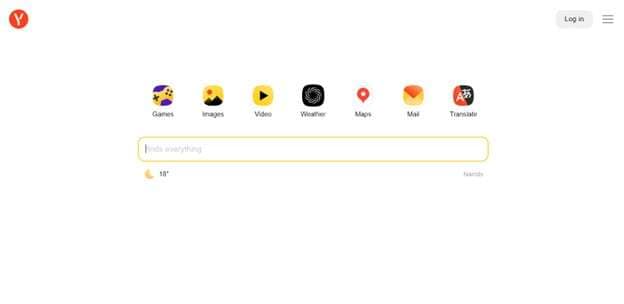
Yandex browser translate video feature automatically detects the language of the loaded pages. It will then ask you if you want to translate it, and allow you to open the translation dialog window once you click the SmartBox. In only a few simple steps, you can translate the languages in any video, text, or image.
- Click “Translate” in the window of the Yandex Browser to translate the page text. From the page text that appears, click Show Original in the window.
- When you play videos, click on the “SmartBox” indicating Translate Video that hovers on top of the video. Choose the language that you want, and select “Show Subtitles”. Yandex will automatically translate the video, allowing you to view it in your native language.
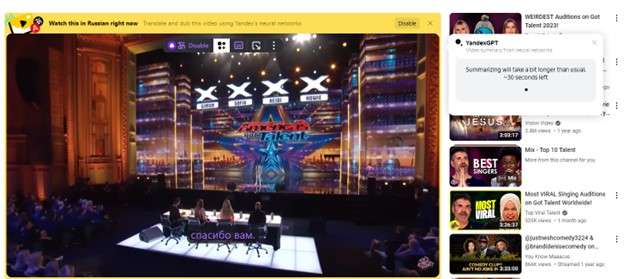
Pros
- Supports Multiple Languages: With Yandex video translate, you can watch any video in over 90 languages
- Accurate Subtitles: The Yandex browser translate video feature automatically generates highly accurate subtitles using speech recognition technology
- Live Translation: Translate any live stream videos in real-time, including conferences and news broadcasts in foreign language
- Offline Translation: Yandex Translate works seamlessly offline by allowing users to download subtitles to their devices for viewing later
- User-friendly Interface: Yandex browser translate video has an easy-to-use and highly intuitive interface that requires users to only click on the Translate button to access the subtitles
Cons
- Users have complained that Yandex translate videos often contain some errors in pronunciation
- Live translation and online video translation usually require an internet connection, and may not always be useful
- The video translation feature is only limited to the desktop version of the Yandex browser
- Users have limited control of the Yandex video translation process, including customizing the subtitles or changing the translation process
- Certain features may be technical for some users and only support certain video formats like MP4 and WEBM
Part 2. Google vs. Yandex: A Comprehensive Comparison
Making a choice between Google and Yandex for video translation can be challenging. The two search engines offer unique experiences and allow users to achieve various tasks. However, each has its strengths and weaknesses. As you explore the options for Google Translate Yandex, let’s have a look at what stands out the most for each.
Here is a quick comparison:
| Metrics | Google Translate | Yandex |
| Supported Languages | 135 | 102 |
| Maximum Documents File Size | 10MB | 5MB |
| Supported Image Formats | JPG, JPEG, PNG | JPG, PNG, GIF |
| Website Translation | Yes | Yes |
| Mobile App | Android & iOS | No |
| Offline Use | Yes | No |
| Translate History | Yes | Yes |
| Voice Input | Yes | Yes |
| Translate Handwriting or Virtual Keyboard | Yes | No |
| Translate Widget | For Android Users Only | Yes |
For a comprehensive comparison, keep reading!
1. Google Translate
Google Translate is widely used both on PC and mobile devices. The easy-to-use feature instantly translates languages in text, images, documents, and websites. With an impressive range of 130+ languages, Google Translate appeals to a whole range of audiences.
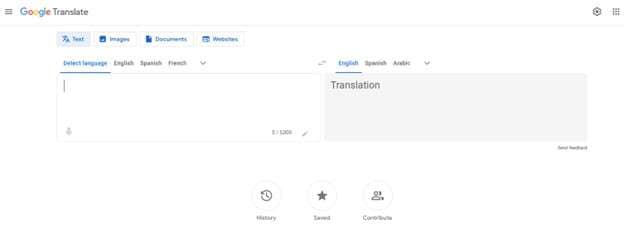
Strengths:
- Larger language support: Supports over 100 languages, making it more versatile.
- Wider platform availability: Available across the web, mobile apps, and various integrations.
- High accuracy: Generally considered the industry standard for translation accuracy.
- Advanced features: Offers offline translation, dictionary lookup, and image translation.
- Extensive data: Trained on a massive dataset, leading to more natural translations.
Weaknesses:
- Limited context sensitivity: May struggle with complex sentences or cultural nuances.
- Limited customization: Users have limited control over the translation style or tone.
- Privacy concerns: Google collects user data for its translation engine.
2. Yandex Translate
The Yandex Translate feature boasts synchronized translation for 102 languages. The feature can translate documents, videos, images, documents, and other forms of media. It also comes with additional capabilities such as predictive typing, pronunciation, dictionary with transcription, context, and usage examples.
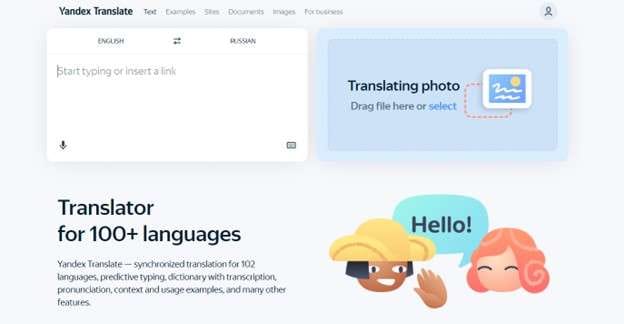
Strengths:
- Stronger in Eastern European languages: Offers superior accuracy for languages like Russian and Ukrainian.
- Live translation: Provides real-time video translation for live streams and conferences.
- User-friendly interface: Simpler and more intuitive interface compared to Google Translate.
- Offline translation: Allows downloading subtitles for offline video viewing.
- Strong in technical terms: Handles technical jargon and terminology more effectively.
Weaknesses:
- Limited language support: Supports fewer languages than Google Translate.
- Limited platform availability: Primarily available on Yandex Browser.
- Less accurate for some languages: May struggle with languages outside its focus area.
- Fewer advanced features: Lacks some of the features offered by Google Translate.
- Less data: Trained on a smaller dataset, which can affect translation accuracy.
3. Choosing the Right Tool for Your Translation Needs
The choice between Google Yandex translate options will depend on your specific needs. Each search engine has its own unique features that make it useful for various kinds of users.
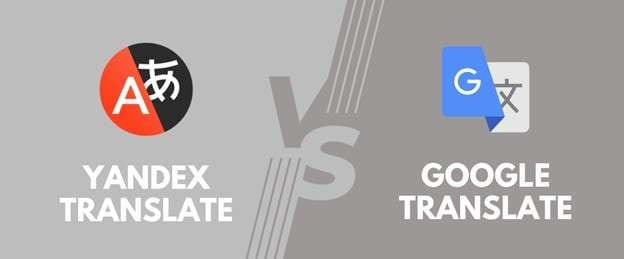
When you need translation for a wider range of languages and platforms, you will find Google Translate a better option. However, Yandex Translate is a better choice when looking to translate Eastern European languages. It is also more useful when you are interested in translating live streams and news broadcasts in a foreign language. In the end, both search engines are helpful and will achieve the desired goal.
Part 3. Pro Tips for Efficient Video Translation
Achieving efficient video translation starts with choosing the right translation. As explained in the previous section, Google and Yandex Translate features are easy to use and produce great results. However, you need to consider your language needs and the level of accuracy you are aiming for before making a choice. To achieve better results, software designed to specially translate videos will do a better job.
Best Free Online Video Translator – Wondershare Virbo
Wondershare Virbo stands out as an effective tool that accurately translates videos in minutes. The AI-powered tool is designed to translate videos, or even generate engaging videos almost instantly. You can further convert text into professional spokesperson videos or translate the voice in your videos to the desired subtitles language. This easy-to-use and provision of great results within a short time makes Virbo a good choice for various kinds of projects. You only need to upload your video to the software, and Virbo will do all the heavy lifting.
Translate Video Online Free Download
Compatibility of Wondershare Virbo:
- Online, Windows, Android, iOS devices
Key Features of Wondershare Virbo:
- AI Video Translator : This feature allows you to achieve global communication with Virbo. Easily translate video content in over 20 languages for viewership and audience needs.
- Auto-Generate Script: Virbo eliminates the need to manually write your script by automatically generating it and ensuring consistency in language and tone.
- AI Cloning Voices: Virbo infuses emotion and vitality in your videos to appeal to different kinds of audiences.
- Lip-Sync Precision: With high precision in lip-sync, every part of the video is harmoniously synchronized to a great viewing experience.
- Soundtrack Reserved: Virbo enhances audience engagement by making video content more memorable.
**

Pros
- Virbo is widely compatible with different kinds of mobile and PC devices, offering a more versatile experience
- An affordable video translator tool that offers budget-friendly prices for all kinds of users
- An easy-to-use and intuitive interface for accurate video subtitle translations
- Multiple language support for various video needs
- Translate videos in the same platform without having to edit subtitles manually
Cons
- Limited language support compared to some advanced and paid options
- Lacks advanced features offered by paid services
How to Use Wondershare Virbo to Translate Video
How to translate video with Virbo? You can do this by following the instructions provided below:
Step 1. Open the Wondershare Virbo Online Tool
Click “Translate Video Online” to open the Wondershare Virbo online tool on a browser. You can also download it on your computer or mobile device.
Translate Video Online Free Download
Step 2. Access Video Translate and Upload Video
Following this, proceed with the “Video Translate” feature from the “More AI Tools” section. Upload your video file by tapping on the “Click to upload video” option, and the video length can be a maximum of 5 minutes. Moreover, the maximum supported file size is 500MB, and file types are MP4 and MOV.
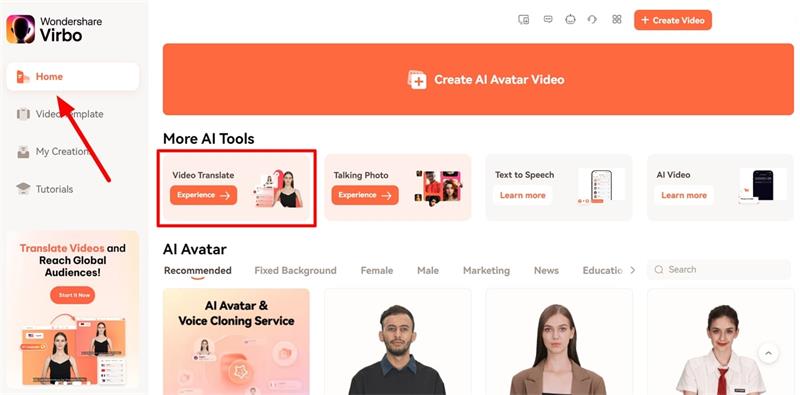
Step 3. Choose Target Language and Advanced Settings
Before starting the video translation process, you need to choose the “Target Language” and enable other advanced settings such as Lip-sync, Subtitle, or Proofread video script. After that, press the “Translate this video” button to initiate the AI video translation process.
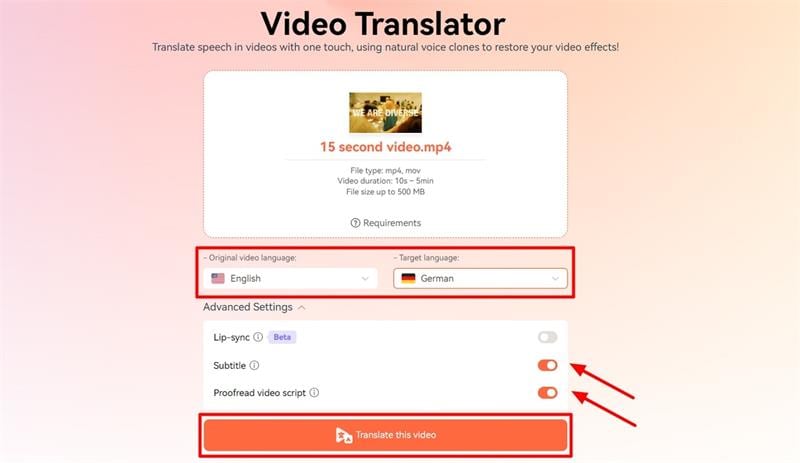
Step 4. Check the Video Script and Finalize the Translation
In case you have enabled the “Proofread video script” feature, you will be able to check the translated video script and edit it according to your requirements. Afterward, press the “Translate video” button and download your translated video once the process is completed.

Translate Video Online Free Download
Conclusion
The Yandex browser video translation is a popular feature for instant and quick video translations. The features work well with different kinds of videos, especially live streams and news broadcasts in Eastern European languages. Although the in-built features offer unique experiences to customers, it is limited in some ways.
Since choosing the right tool is the first step to successful video translation, going with installable software will produce better results. We recommend installing Wondershare Virbo to handle your video translation needs. This is the best free online video translator that is AI-powered to meet the specific needs of various kinds of audiences.
Also read:
- [New] 2024 Approved Android & iOS Prime ASMR Software Options
- [Updated] 2024 Approved Flipping the Script Mobile Filmmaking & YouTube Thumbnail Tricks
- [Updated] Live Broadcast Converter Decoder for 2024
- How to Translate YouTube Videos to English Subtitles for 2024
- In 2024, Complete Guide of Top Video Language Translators
- In 2024, Pro-Level Clarity Top 8K Cameras for the Ultimate Picture
- In 2024, Where Is the Best Place to Catch Dratini On Vivo V27 | Dr.fone
- Meta's Strategy: Abandoning Facebook’s Biometric Tech
- New 2024 Approved Netflix Subtitle Translation Methods Comprehensive Guide
- Social Networks, Meet The New Era: Meta Drop's NFT Venture
- Top 10 Hindi Video Translators with Step-by-Step Guidance
- Ultimate Guide to ManyCam: The Top Choice for Live Streaming and Virtual Cam Effects
- Understanding Vectors First Steps and Essential Apps for 2024
- Updated 2024 Approved 8 Best Multi-Subtitles Translators You Shouldnt Miss
- Updated 2024 Approved How to Translate TikTok Videos? All You Want to Know
- Updated 2024 Approved Top 8 Multi-Subtitles Translators You Can Use
- Updated In 2024, Maximize Yandex Translate in Video Translation and Beyond
- Title: In 2024, How To Convert Video Voice to Text Online for Free?
- Author: Susan
- Created at : 2024-10-03 23:53:45
- Updated at : 2024-10-05 18:56:32
- Link: https://ai-video-translation.techidaily.com/in-2024-how-to-convert-video-voice-to-text-online-for-free/
- License: This work is licensed under CC BY-NC-SA 4.0.

